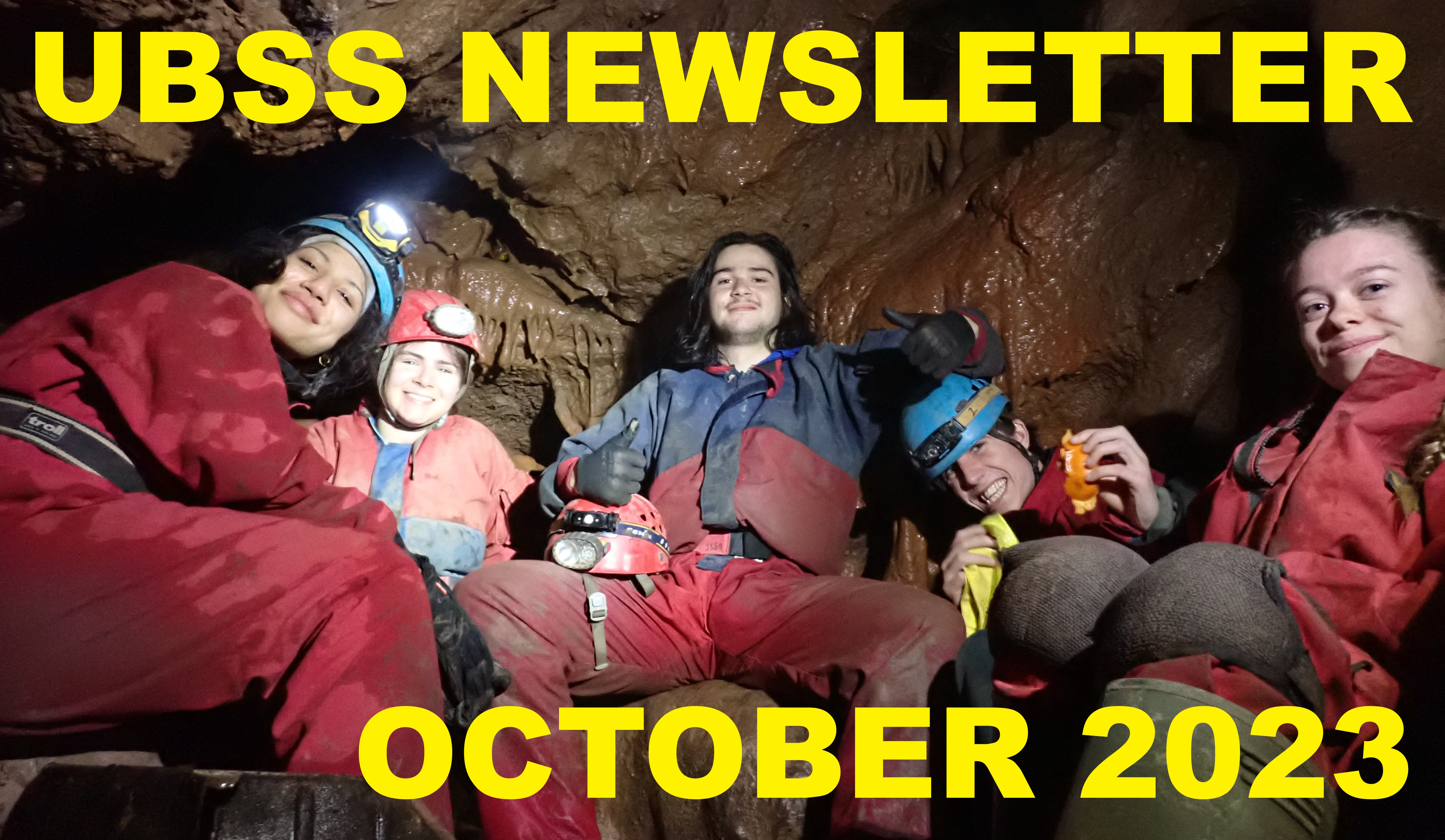 Freshers' Weekend underground in Sidcot Swallet. Left to right: Jositha, Emma, Felix. Will, Jess. Photo by Jess Brock Freshers' Weekend underground in Sidcot Swallet. Left to right: Jositha, Emma, Felix. Will, Jess. Photo by Jess Brock
|
|
It's
been a busy start to the new term, with Freshers' Weekend at the Hut,
followed by a weekend in South Wales and several socials; the Cows' tail
pub crawl, the Bat v. Fish costume extravaganza, the Halloween social.
and the usual Tuesday pub nights There have also been mid-week trips and
the Bonfire Weekend is nearly upon us.
If you haven't already bought your club membership, then head over to the Students' Union website and join now.
If you'd like to drop us a line
about your caving experiences with UBSS, or join our editorial team,
please do get in contact. Trip write-ups - long or short - are always
welcome, as are photos. We'd love to hear what you've been up to, or
down to.
One thing that struck us this month was the number of different ways
cavers have named or described squeezes, we've got a couple of examples
in this issue, and there are plenty of others, but to uphold the honour
of UBSS, we really need a new squeeze to be named the Squeeze Machine.
There you go, a challenge!
We're really grateful to Wessex member Steve Sharp for letting us use
some of his amazing photos of Pen Park Hole! If the article in this
issue fires you with enthusiasm to visit the cave, our club leaders are
Elaine Oliver and Clive Owen.
If you'd like to check out previous issues, you can find them all here. You can also find a scanned archive of all our paper issues from 1919 to 2017 here.
If you're a fast reader, now's the time to throw your caving helmet into
the ring and see who can make it to the end first to meet this month's
caving mascot ... there are even prizes to be had.
Linda and Dan (Hill)
|
|
BATS v. FISH
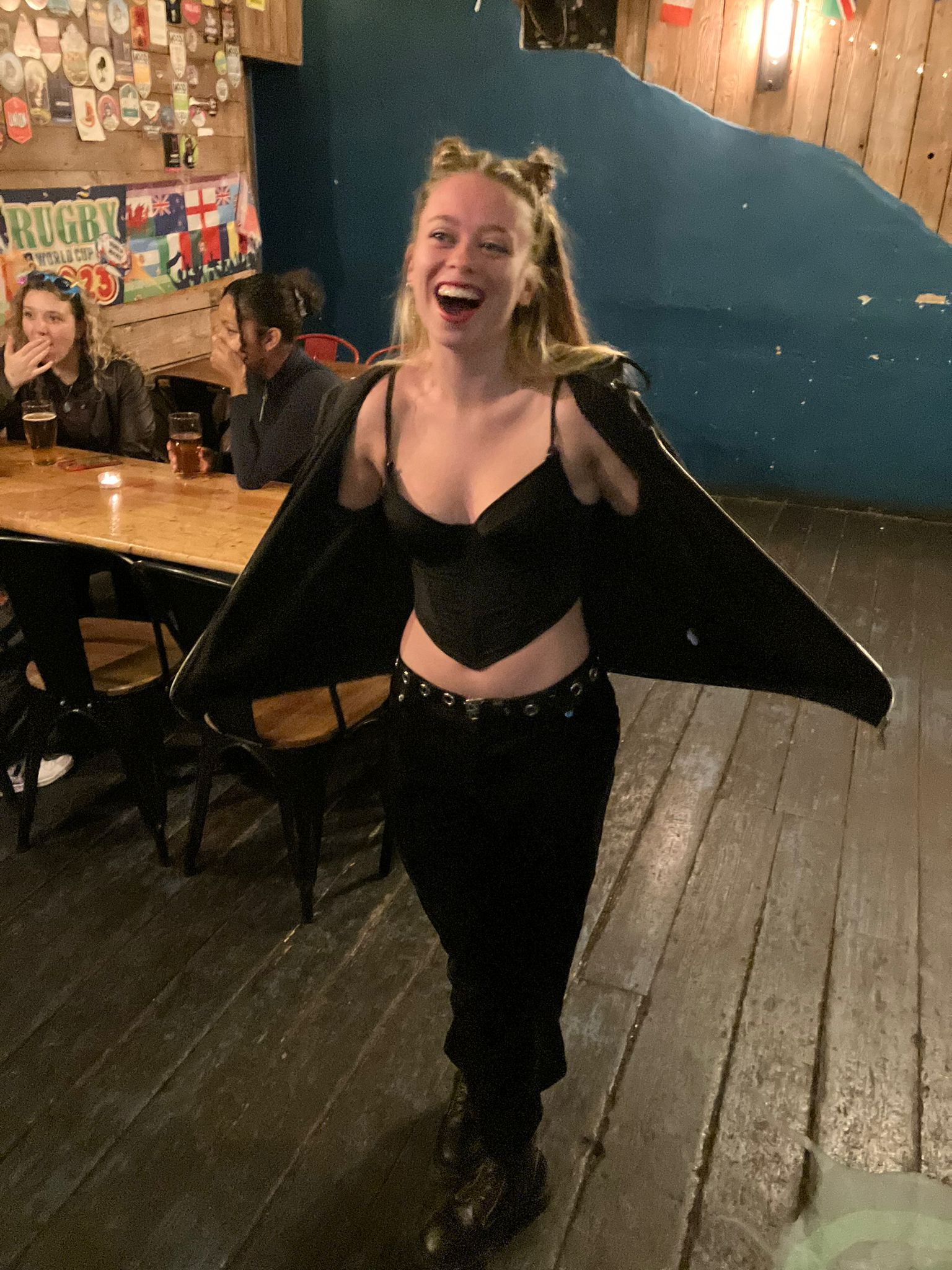
Jess Brock as a bat.
In one of the many socials at the start of term, cavers took on divers in an epic fancy dress pub crawl.
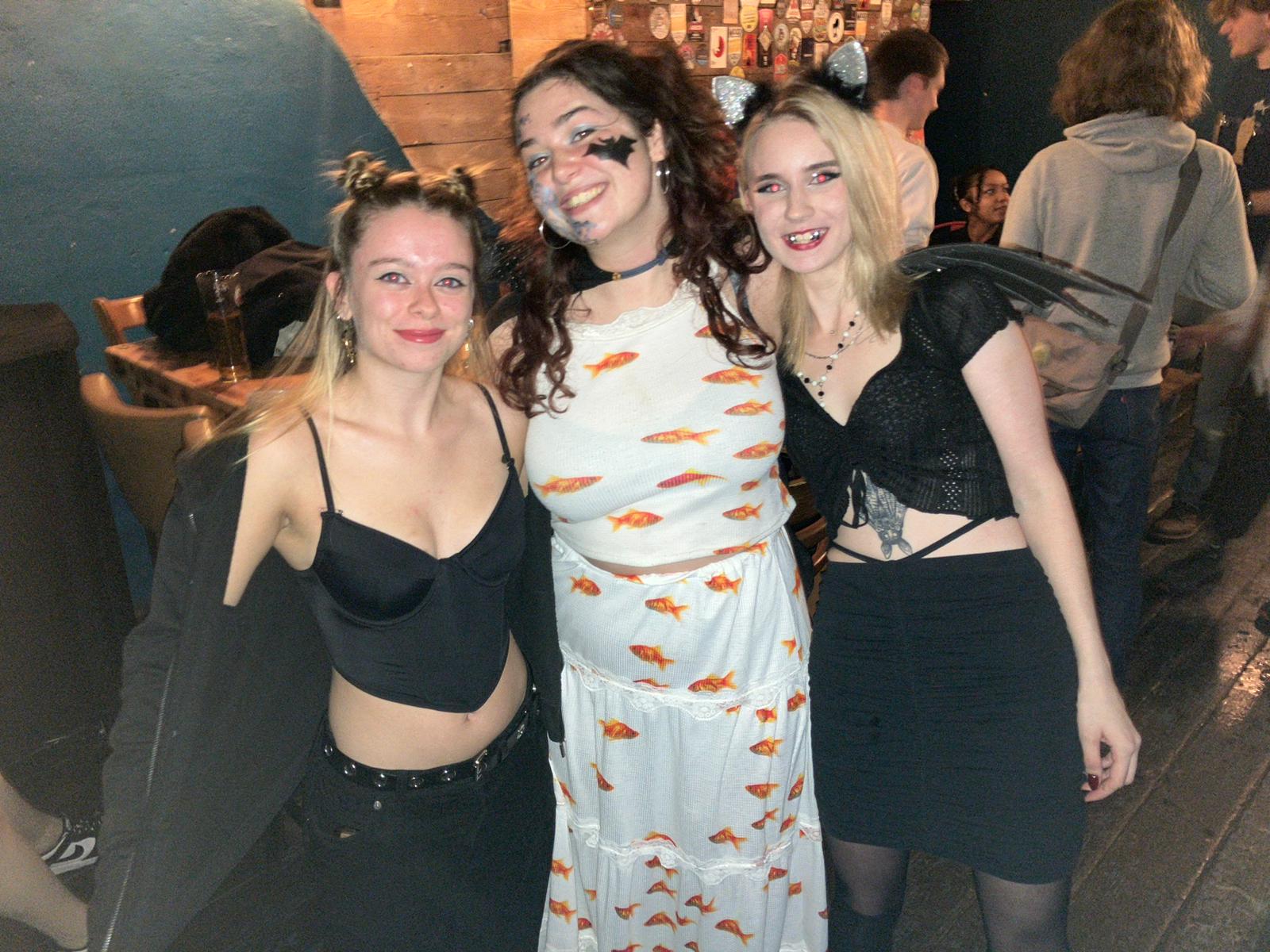
Going batty! Left to Right: Jess Brock, Mia Jacobs, Alysia Ellis.
Naturally the bats won (or at least
according to the UBSS contingent, they did), with the prize for the best
costume going to Alysia!
The best quote of the night from WhatsApp was: "Were you there when the
guy with a paper mache anglerfish accidentally walked in."
Most people reading that no doubt wished they had been!
|
|
LOBSTER POTS
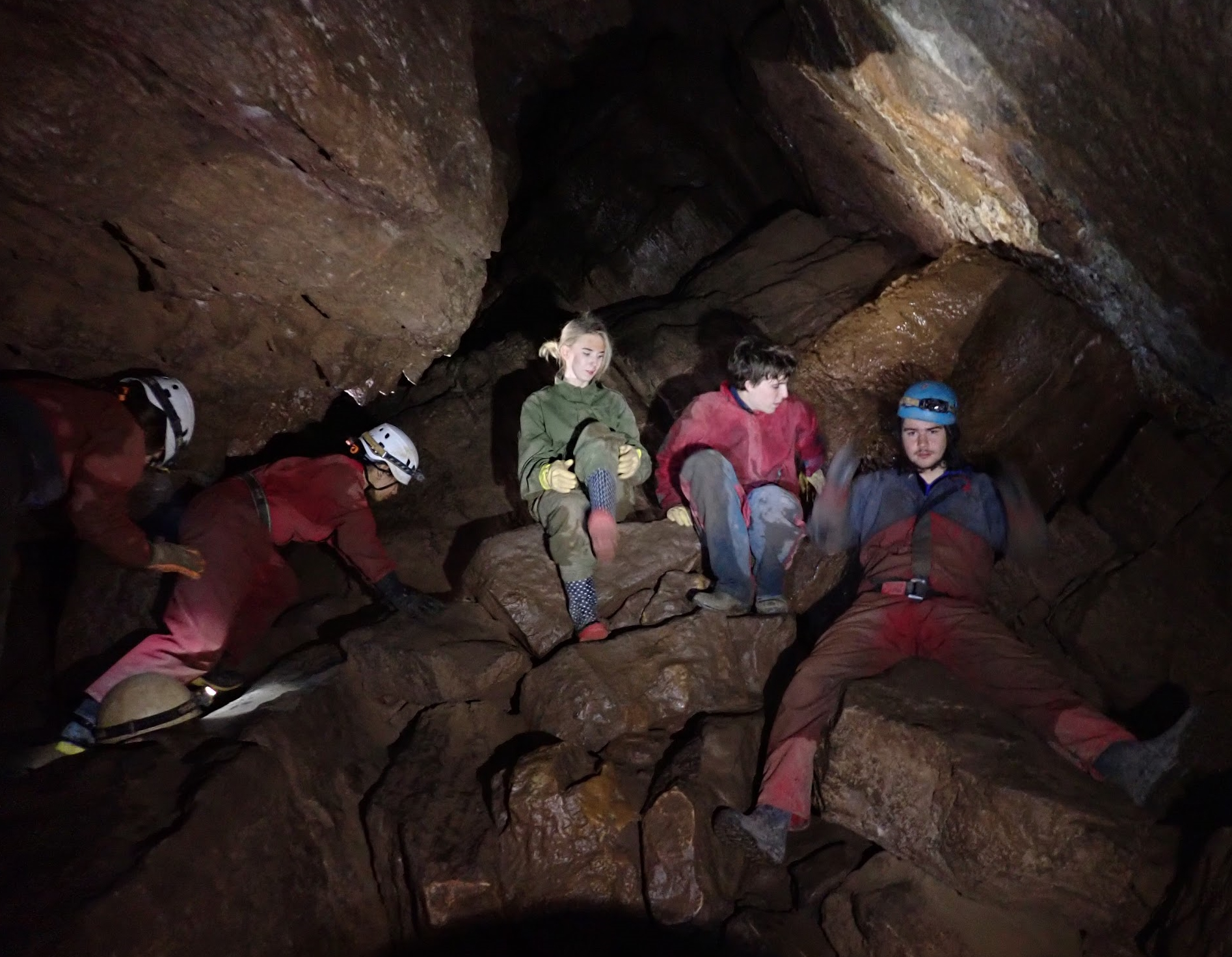
Goatchurch, Boulder Chamber. Left to right: Emma, Joshitha, Alysia, Will and Felix. Photo by Jess Brock.
Loads of new cavers have joined
UBSS and started caving this term, and new member Alysia confirms she
enjoyed her first taste of Mendip and the Hut and Dan follows up with a
few word on the first Welsh Weekend of term and Ryan had fun under a
hillside he already knew well (and how dare anyone suggest we'd resort
to bribery in return for good TripAdvisor reports so no heckling from
the cheap seats!)
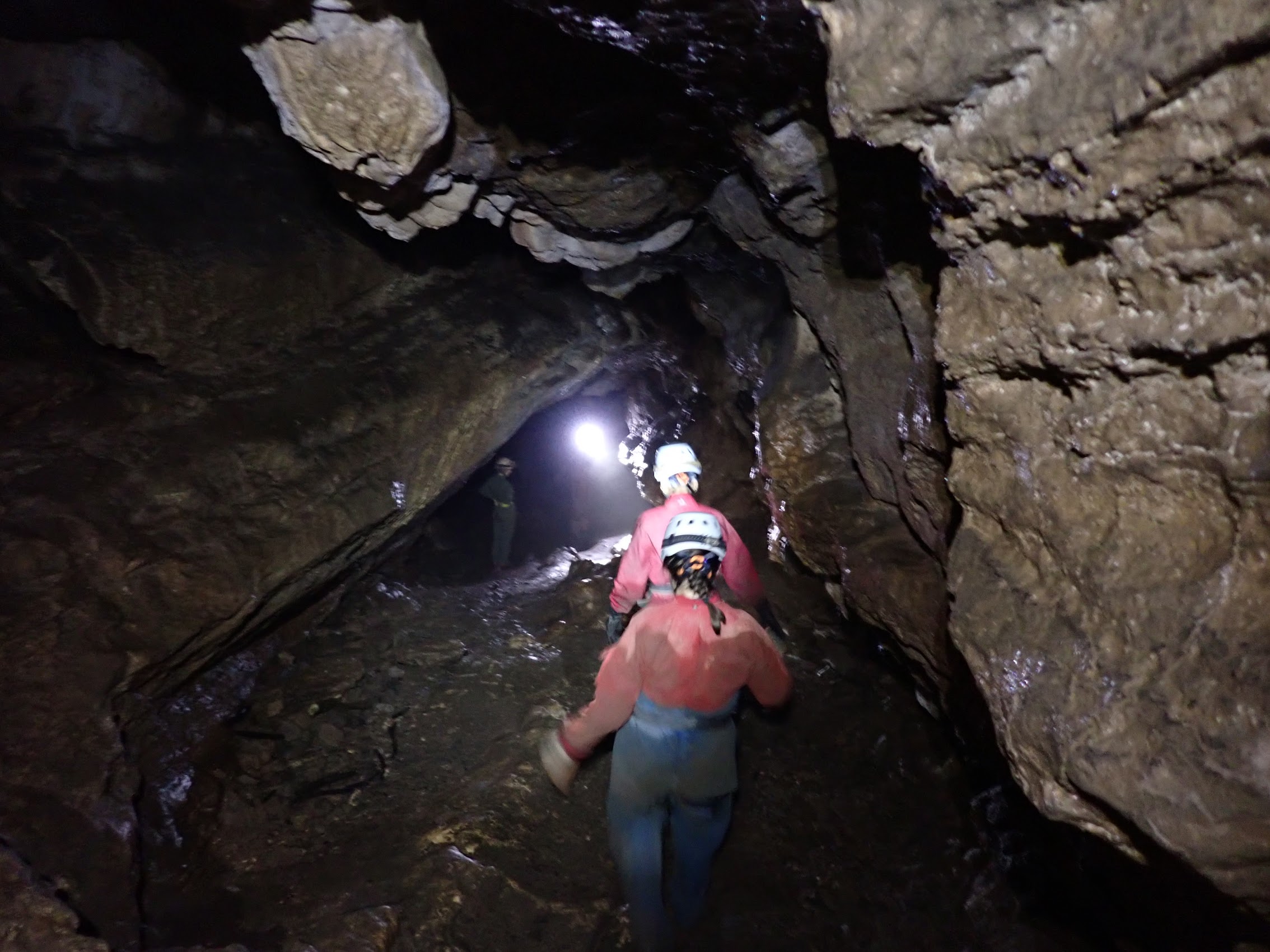
Goatchurch, entrance passage. Photo by Jess Brock
I had the most incredible time exploring some of Mendip’s caves with
UBSS on the freshers trip! My favourite definitely had to be the route
from Bath Swallet to Rod’s Pot- it was really exciting to go down the
ladder pitch and I enjoyed the climbs in the cave a lot.
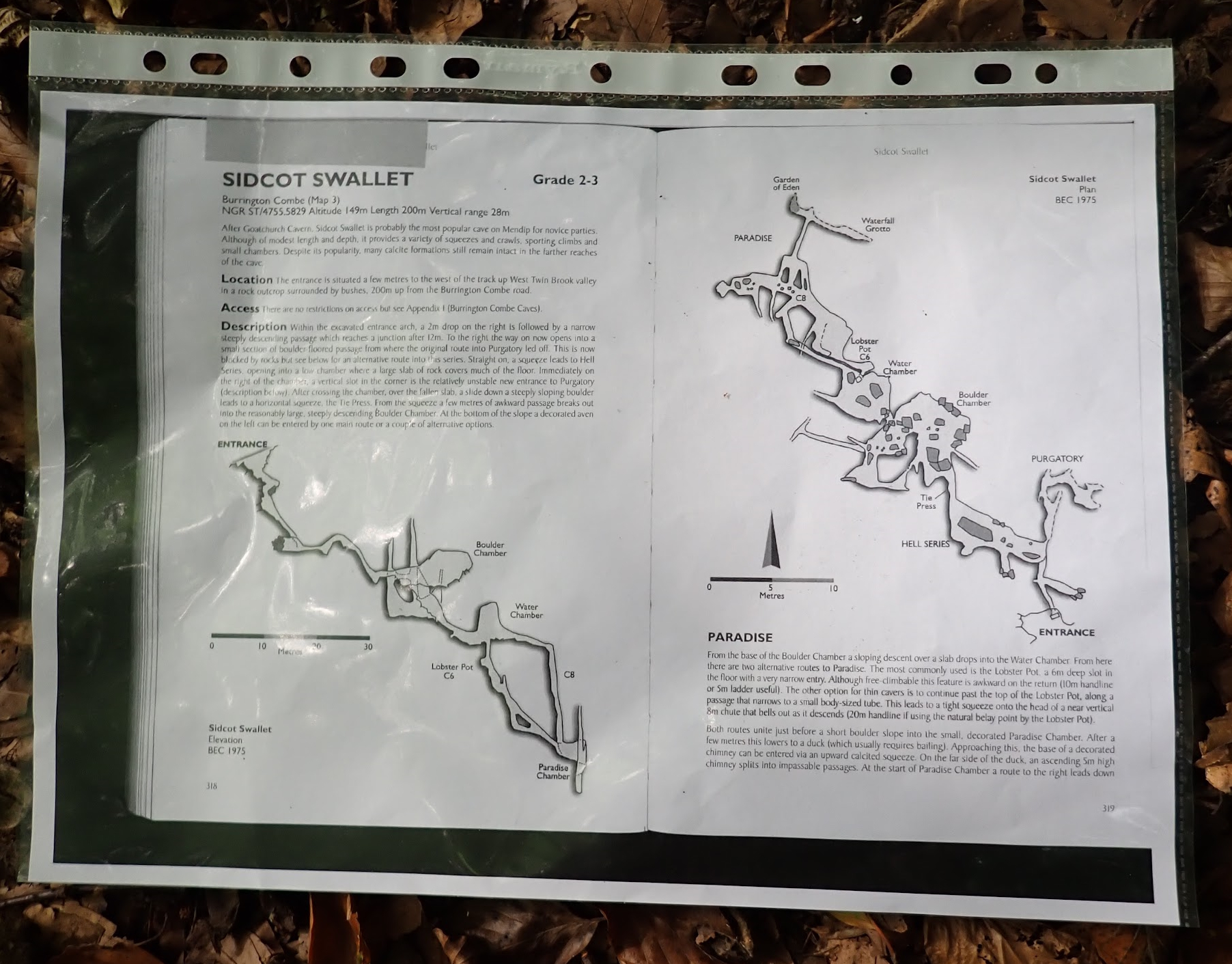
Planning and preparation prevents piss-poor performance. A survey of
Sidcot Swallet, included because we don't have a handy one of Rod's -
Bath.
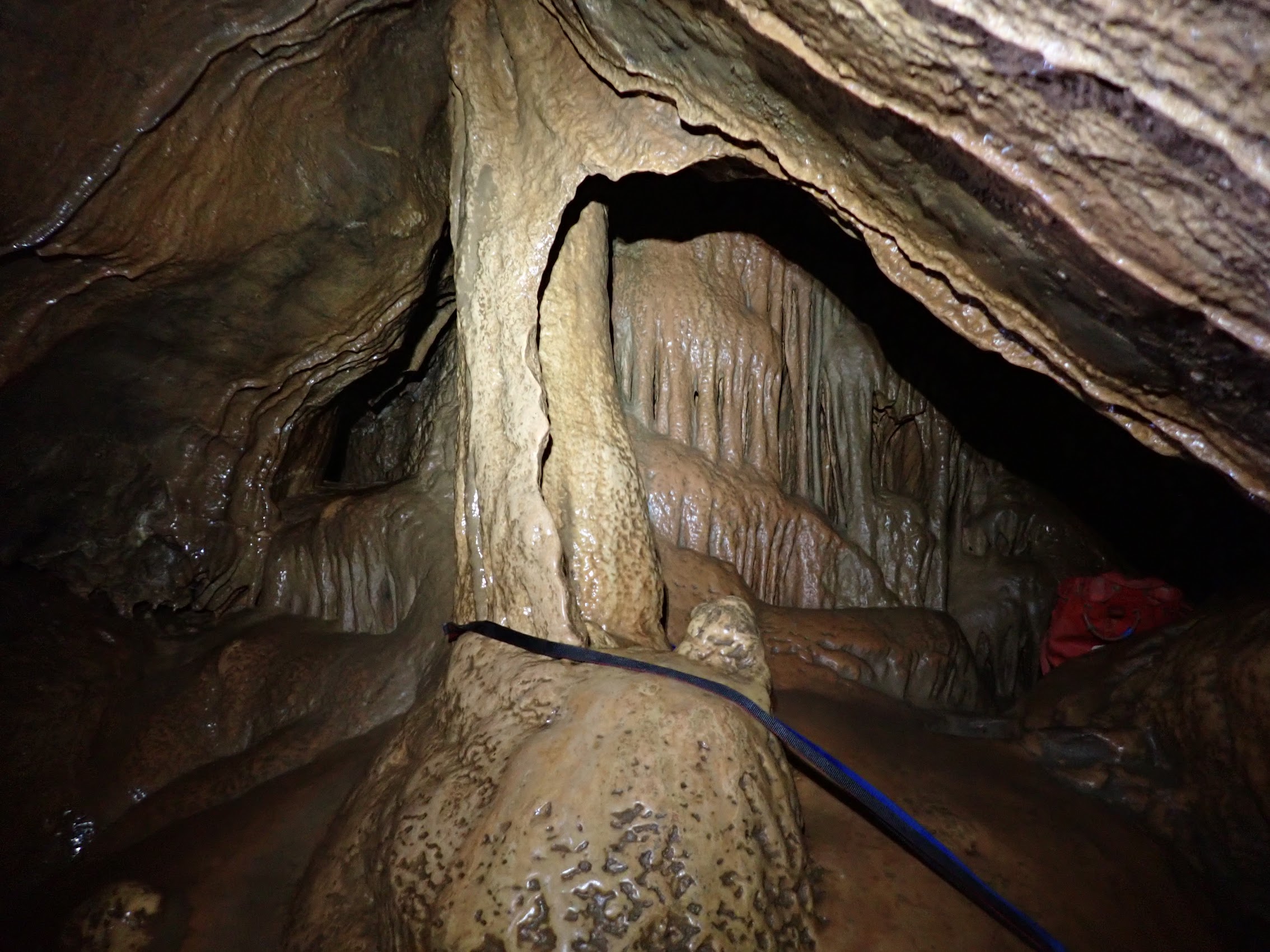
Descending the infamous Lobster Pot in Sidcot Swallett. Photo by Jess Brock.
It was amazing to have the opportunity to
explore places that most people wouldn’t even consider going; the
committee and leaders were all super welcoming and supportive and made
everyone feel comfortable caving. By the end of the trip I felt like I’d
made a lot of new friends and can’t wait for more trips
with the society !
Alysia Ellis
BURNT SOCKS AND A LETTERBOX
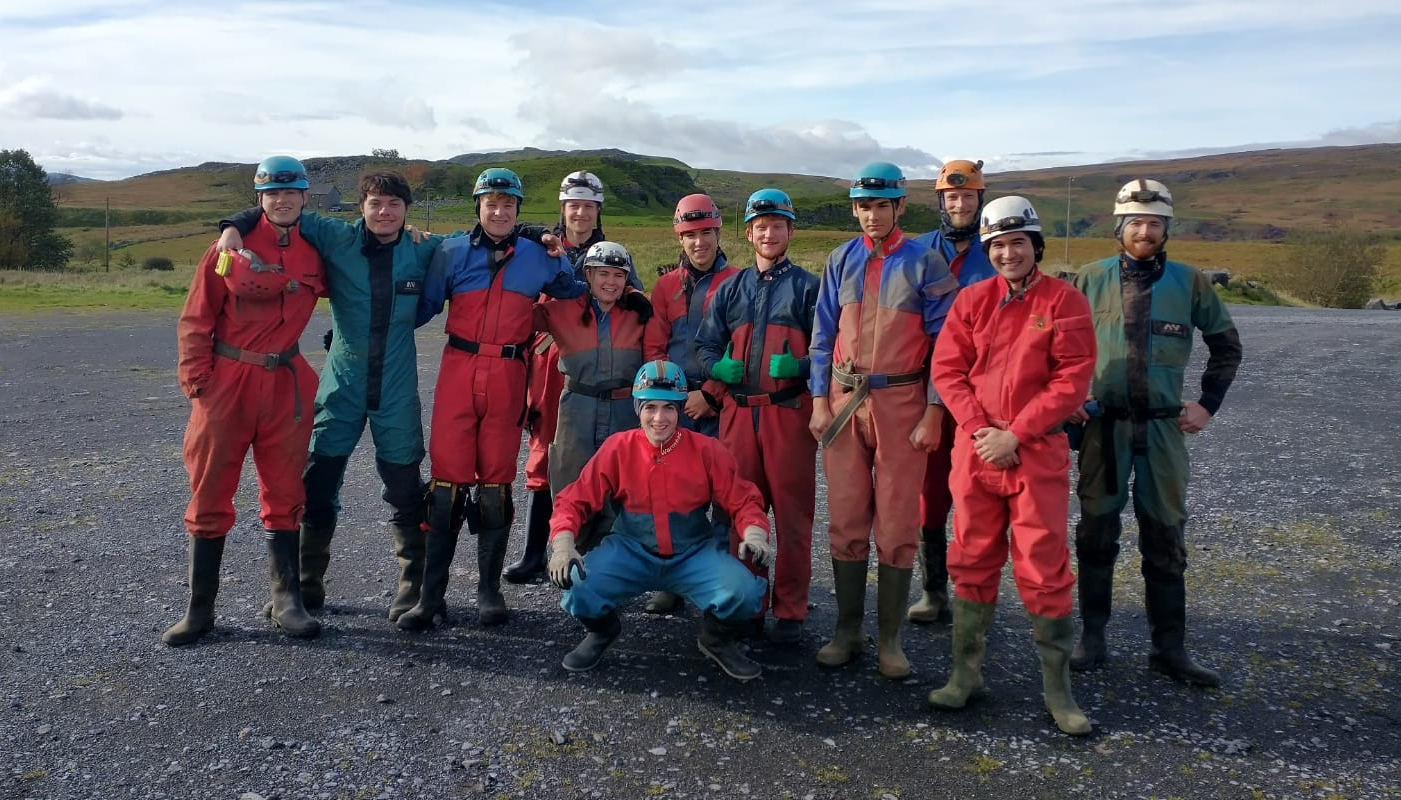
Isn't everyone clean? Right to left: Si,
Ethan, Jacob, Philip, Ryan, Dan, Dan, Emma,
James, Ben, Dan, Jude. Yes, there really were three Dans
on the trip.
After the Mendip weekend, we had
our second big trip of the year, giving our new members the chance to
experience the big and beautiful caves of south Wales.
We stayed at the WSG’s cozy Caerllywn cottage which hosted last year’s
jack-o-lantern cricket. Though we couldn’t connect to the sound-system,
someone was nice enough to leave a copy of ‘Dance Tip 2000’ in the CD
player which, after we played it about 20 times back-to-back, will be
permanently etched in our brains until death. Check it out if you get
the chance.
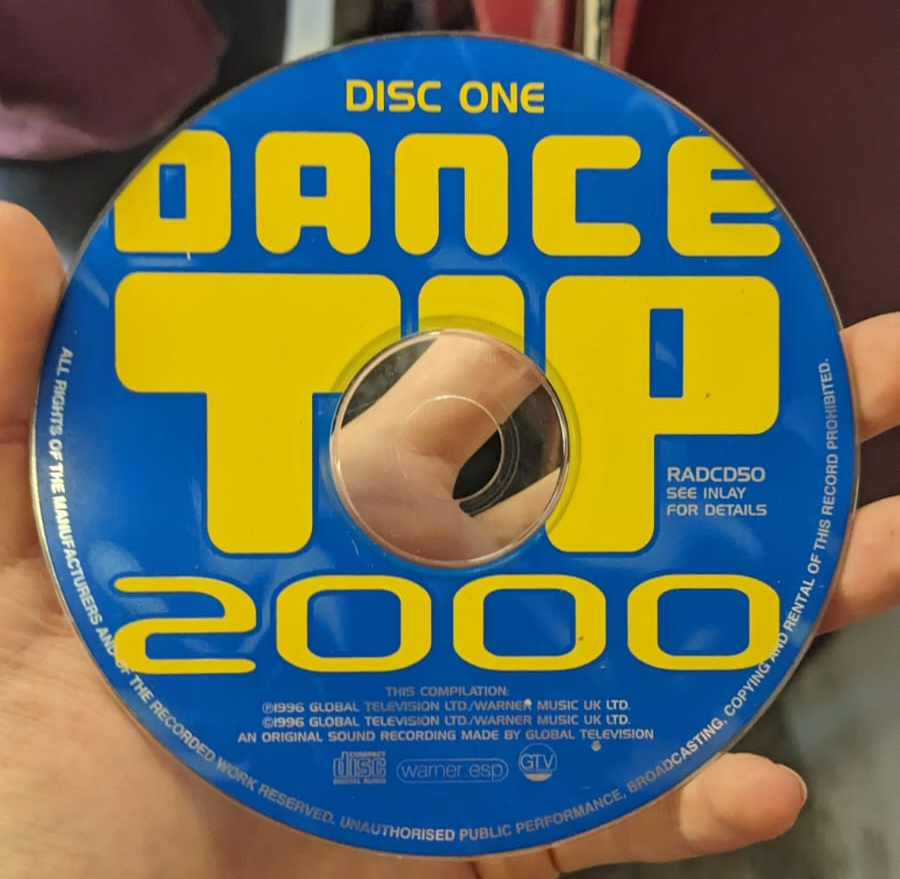
The real star of the weekend!
Two UBSS groups and (at least) three NUCC
groups were crowded into OFD top at the same time, so of course Jacob,
Ryan, Ethan, Emma and I had the genius idea to get lost crawling around
the brickyard for 2 hours in order to avoid the traffic; it worked a
treat.
On the second day (after a better-left-unmentioned amount of time at the
whiteboard), we managed to do the impossible: managing to arrange three
caving trips with only two cars. We even fulfilled Ben’s dream of a
Craig a Ffynnon trip and squeezed in a bottom-to-top OFD through trip
(see Ryan’s piece for the details).
Overall, the weekend was a great time full of whisky, spoons, chilli,
burnt socks, mycological research, and Dance Tip 2000.
Dan Hill
Having lived near Penwyllt my whole life, I
am well familiar with the beauty of the nearby countryside, but until
the South Wales weekend had never had the opportunity to explore what's
beneath. Armed with a Lion bar and Yorkie, we began our through trip at
OFD 1, descending the ladder and quickly reaching the stream way, which
we stubbled through with pace.
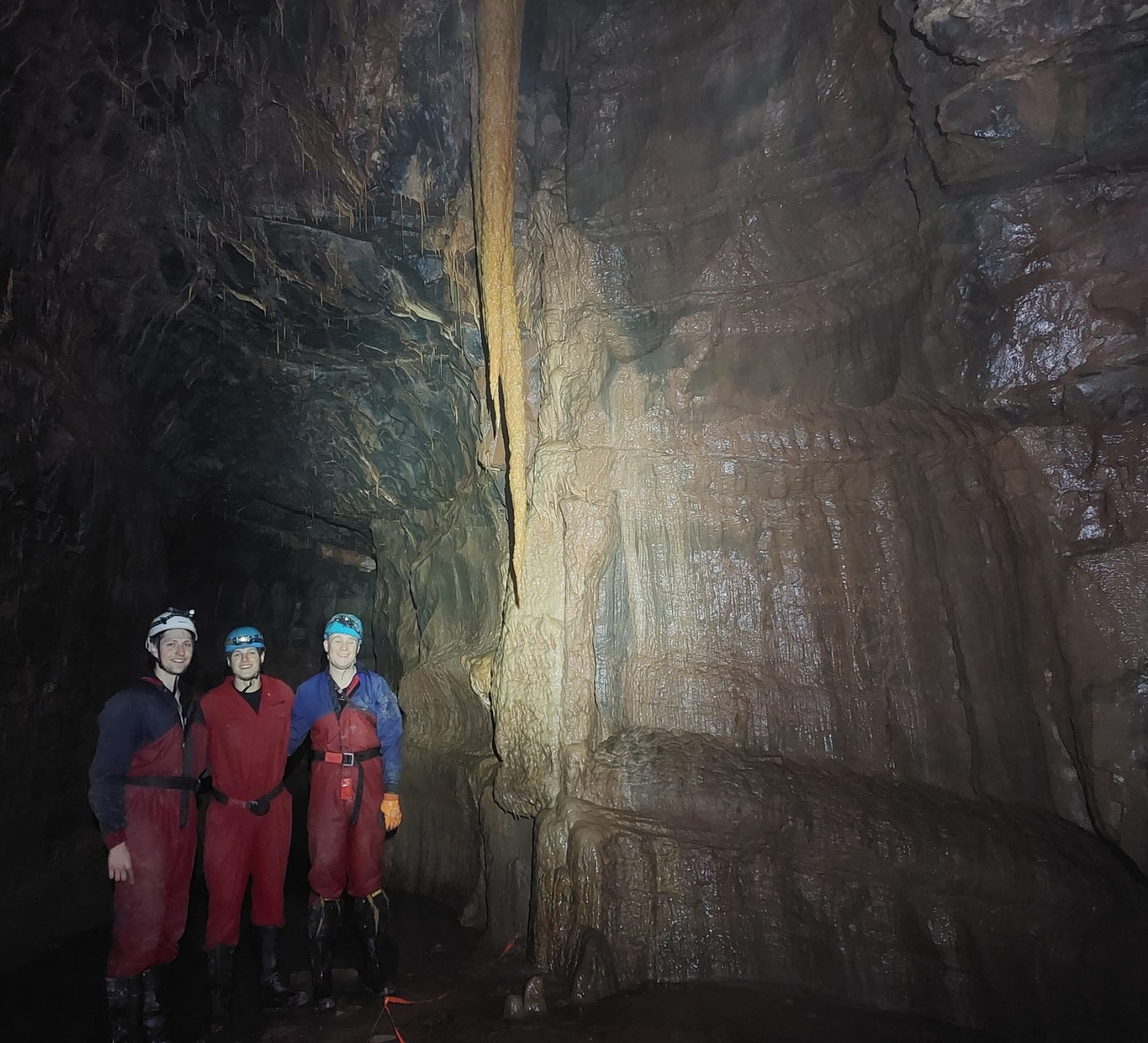
The Trident, OFD Top.
Over the next four hours, we encountered
challenges such as the Letterbox, the subsequent crawl and the Diver's
Pitch (not recommended for those scared of heights) ((me)), which all
presented a good mix of challenge and adrenaline. I particularly enjoyed
seeing how the streamway changed as we moved upstream, and the
different ways to navigate it as a result. As a new caver, this trip
presented its challenges but through perseverance, we reached the top
entrance, the refreshing smell of the outside hitting a few metres from
the exit.
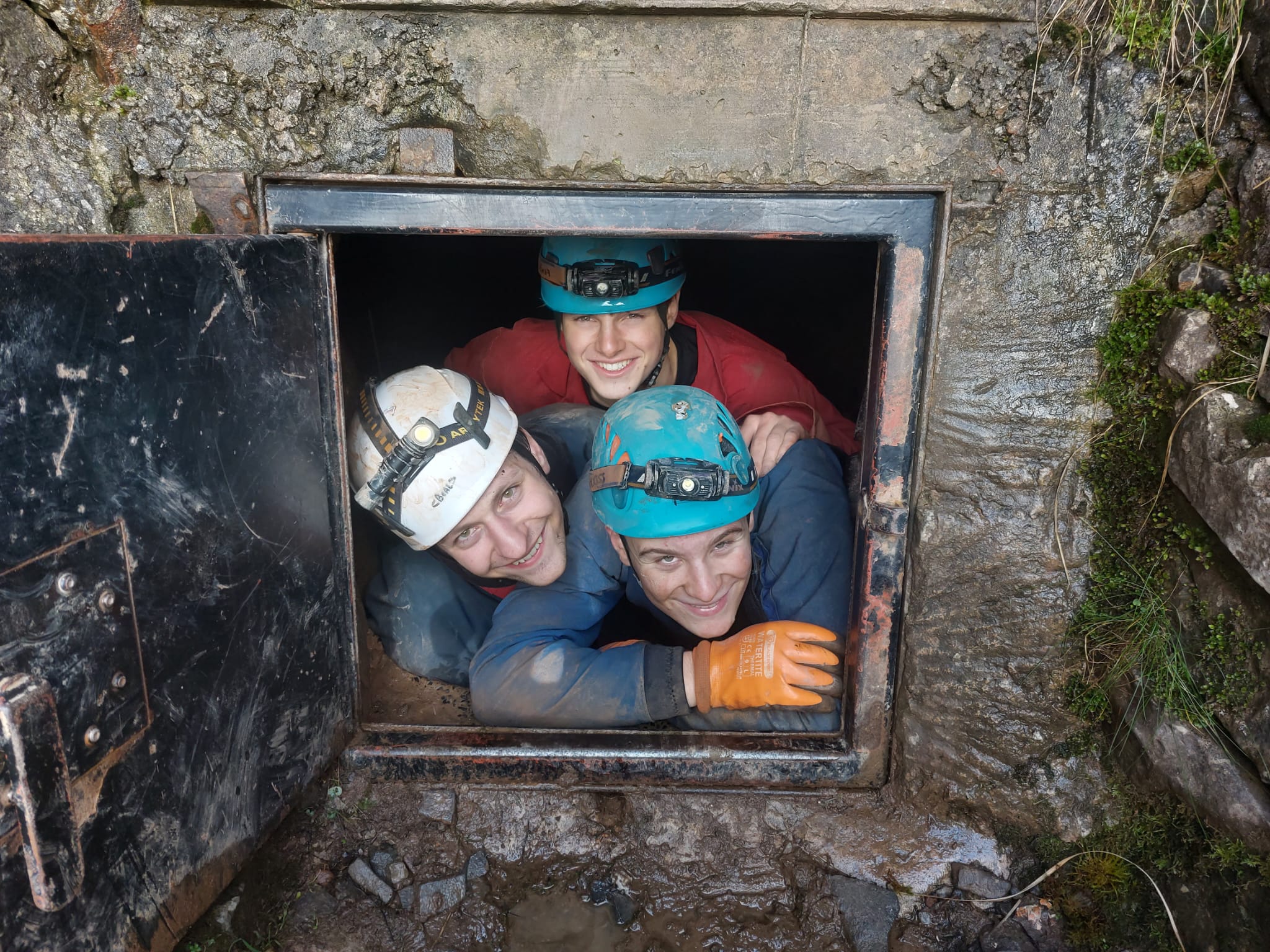
Top entrance, OFD. Whether these three
smelt refreshing by this stage was open to debate! Top: Jude Clayton,
bottom left, James McMillan-Clyne, bottom right, Ben Alterman.
Overall, the trip only increased my eagerness for more caving, roedd hi'n bendigedeg. (It was fantastic!)
Ryan Mattick
|
|
|
DOLLYTUBS AND CHEESE-PRESSES

Looking out into Alum Pot. Photo by Jess Brock.
Tackle Warden Jess Brock recently returned to her old haunts for a trip Up North, and demonstrates that the Dales can top South Wales' famous Letterbox with a Cheese-press!
For twenty years the Northern Pennine Club (NPC) has held Family Meets in October so kids can go caving. No longer children we still meet up every year and spend a weekend exploring the caves of the Yorkshire Dales.
This year on 22 October, four of us ‘kids’ went down Long Churn to Dollytubs with no adult supervision. It was a great start when just as we got to Alum Pot, Becca realised she’d forgotten her helmet and had to walk all the way back to the car. The rest of us carried on to the entrance and Nem talked me through how to rig the pitch. Eventually Becca rejoined us and we made our way into the cave.
It was a pleasant splashy cave that summoned some memory of being a kid in waterproofs, tiny wellies, and a crappy headtorch. Now I was in an oversuit with my well-loved SRT kit clanging at my waist. The Cheese-Press was as tight as I remember, surprising as I’ve grown quite a bit since I was last down there.
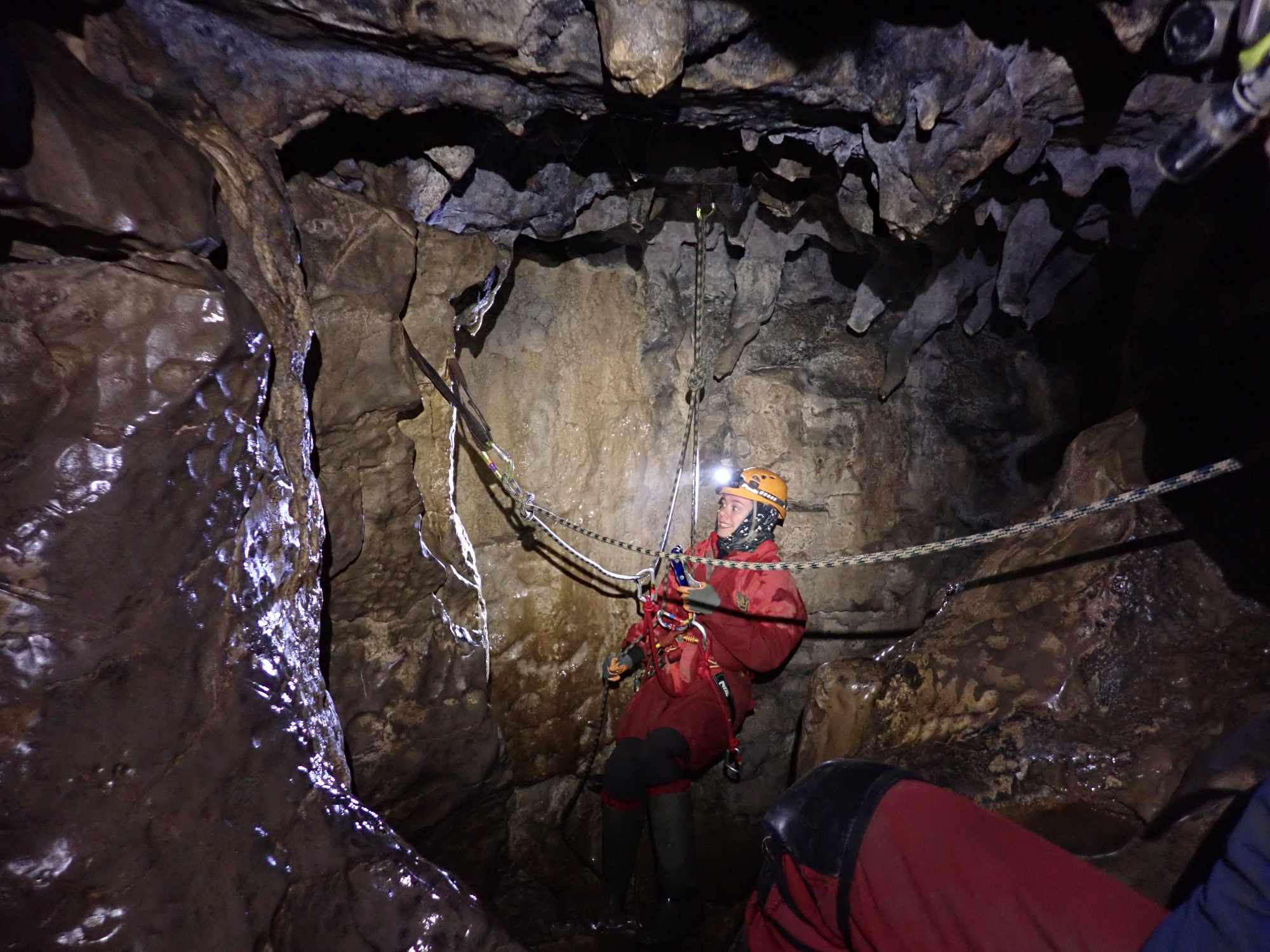
Jess trusting her own rigging.
We got held up at the top of the pitch as Manchester took their time coming back up. There was the usual ‘Who are you?’ and then the subsequent ‘Do you know this person?’ they did, in fact, know our common denominator and soon made their merry way out. For the first time in my long old caving career, I rigged a pitch. I had to stand on the tops of my toes to reach the P-bolt and surely I knew not to look down. With fresh fear in my eyes I tested my handiwork and safe to say everyone made it down alive.
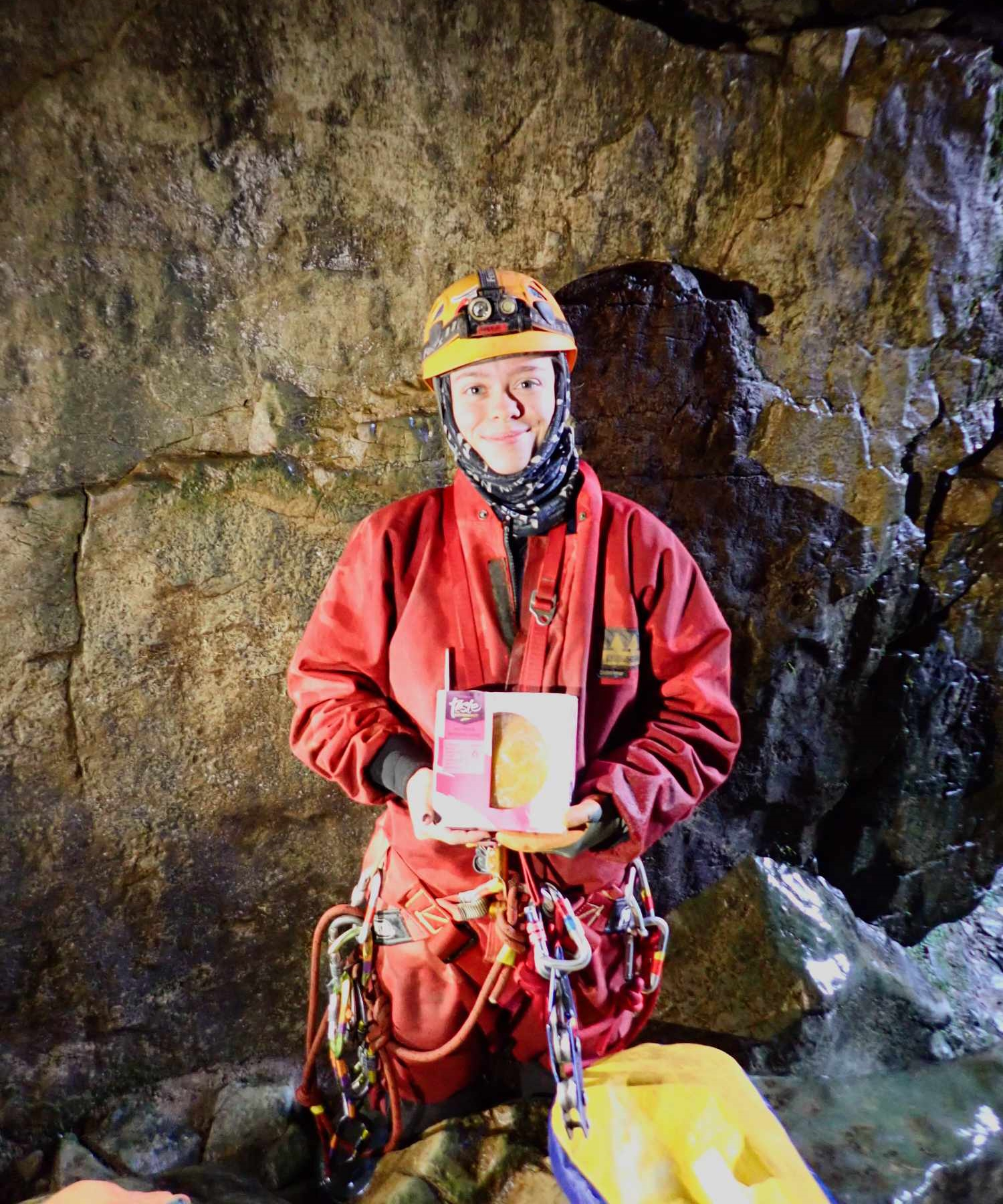
Jess and the Cake!
We made it to the ledge and marvelled at the daylight and the waterfall before sitting down and eating a cake I had courageously carried down without squishing.
Jess Brock
|
|
HOT CAVING IN FRANCE
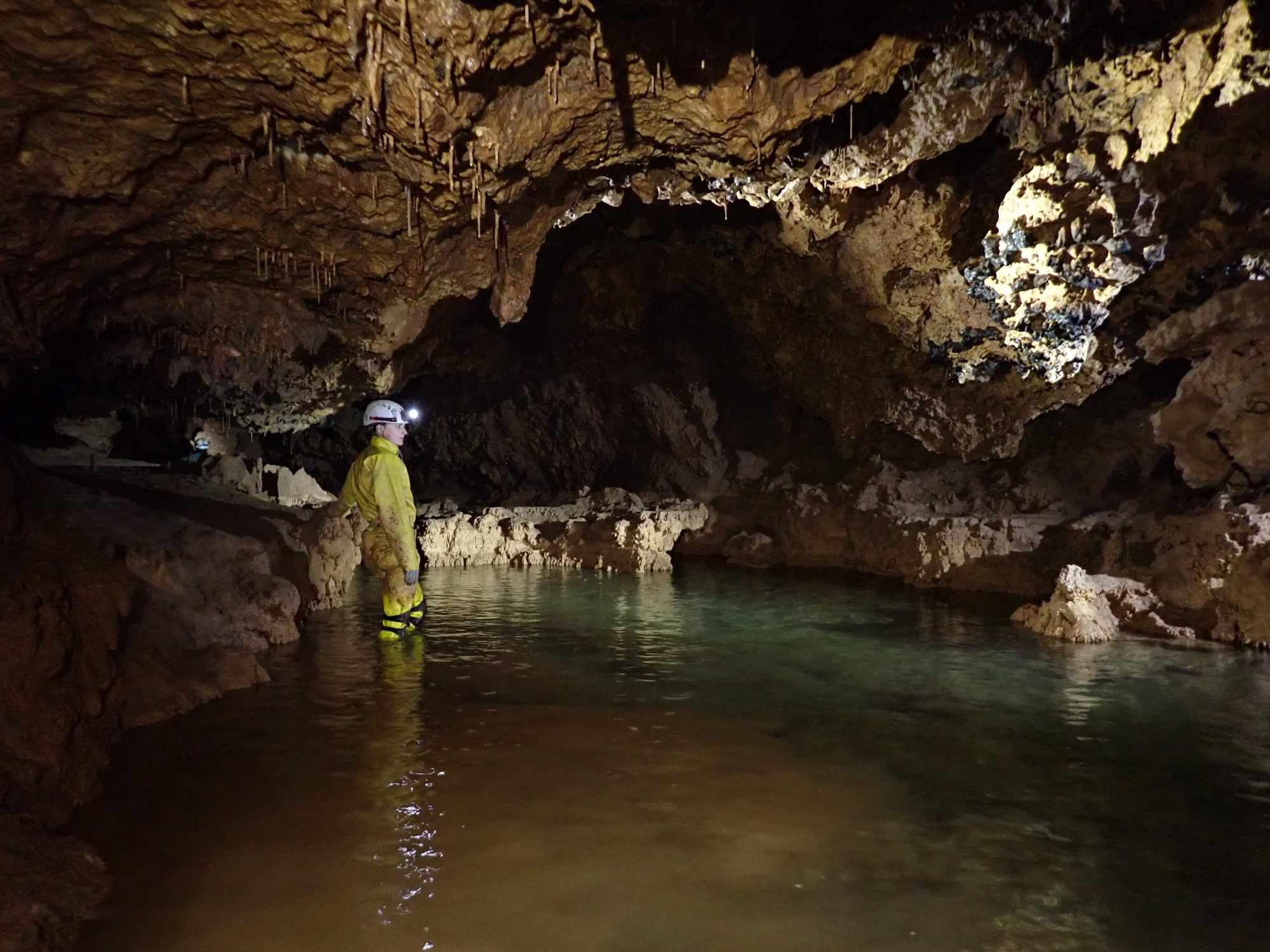
Chloe in Grotte du Coutal. Photo by Jess Brock.
The summer usually sees cavers disperse to various parts of the
globe. This month, our Foreign Correspondents are Jess Brock (France)
and Zac Woodford (Austria). First up we have Jess on caving in France
during a heatwave ...
Deep in the Tarn Gorge lies the Grotte du
Coutal. The cave sits in a rocky cliff face, nestled near the river. A
steep but short walk up resulted in the whole group needing a rest
before we even attempted the cave. Heatstroke would not have been a good
start to the trip.
The entrance was very easy to find as it is marked by a metal door frame
in the rock. Steps have been put in at one point. These slope downwards
and made a nice platform for us to struggle into our gear. Greeted by a
bat, we changed on the concrete steps in the cool before descending
down to the left.
There were a few short pitches which I’m sure the most eager of climbers
could have tackled with a lifeline but SRT was the easiest way down.
There were interesting formations, including tiny curling helictites.
Some of the stalactites were as thick as my arm.
After several crawls we then popped out into a chamber and had a rest.
Caving in France during a heatwave even included the caves warming up.
Eventually after a bit of stooping we found our way into a passageway
tall enough for everyone to happily stand up. With a hop, skip, and a
jump we crossed pools until they grew wider and deeper. Soon enough we
sat at a stunning bluey-green pool and ate our chocolate bars before
making our way out.
Jess Brock
|
|
COLD CAVING IN AUSTRIA
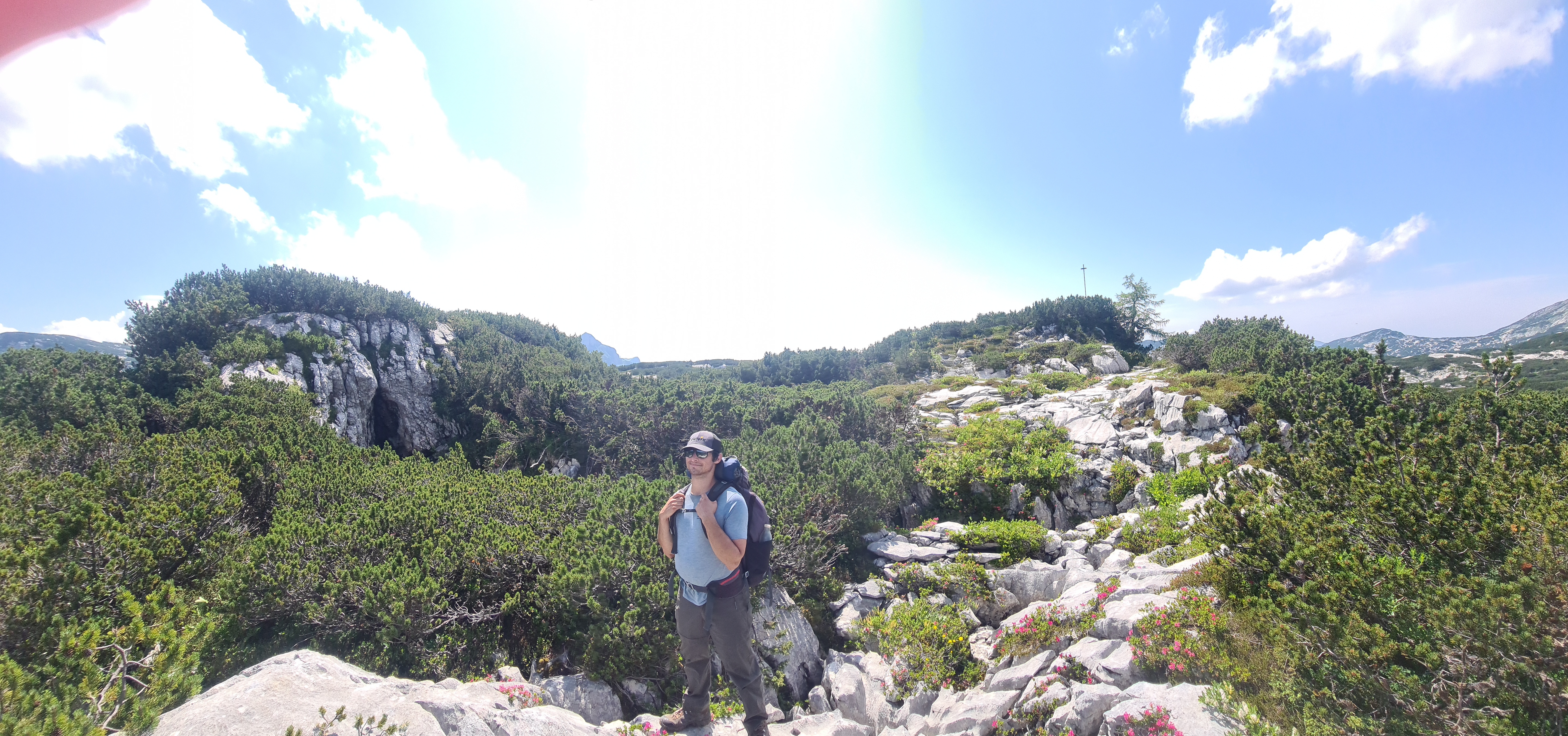
Tempest entrance (left), Ely (right).
Zac Woodford describes the
exploration of Tempest, during the 1023 Austria Expedition, where UBSS
member Ash Gregg lived down to his reputation - again.
Tempest is a new cave that was discovered
the second week into the expedition when Tom, Merryn, Joel, and Lizzie
went prospecting around Fish-face. Initially named ‘The Tomb of Christ’
after the large cross nearby it was swiftly renamed after it was
discovered to actually go somewhere. Ash and I were called in during the
third week to help explore its depths. A decision I think Joel may have
regretted on some level as up until this point Ash had garnered a
reputation for killing caves (see Ampithetre for example).
We had a little fun getting there, taking an unorthodox route through
the Bunda. The entrance though is unmissable, a giant portal in the side
of a very prominent rock-rise. It almost looks like a cartoon depiction
of a cave. When we arrived, the group before us (Tom, Joel, and Lizzie)
were still descending. Given the recent discovery of the cave, the
entrance series was still very unstable meaning that you had to go one
at a time.
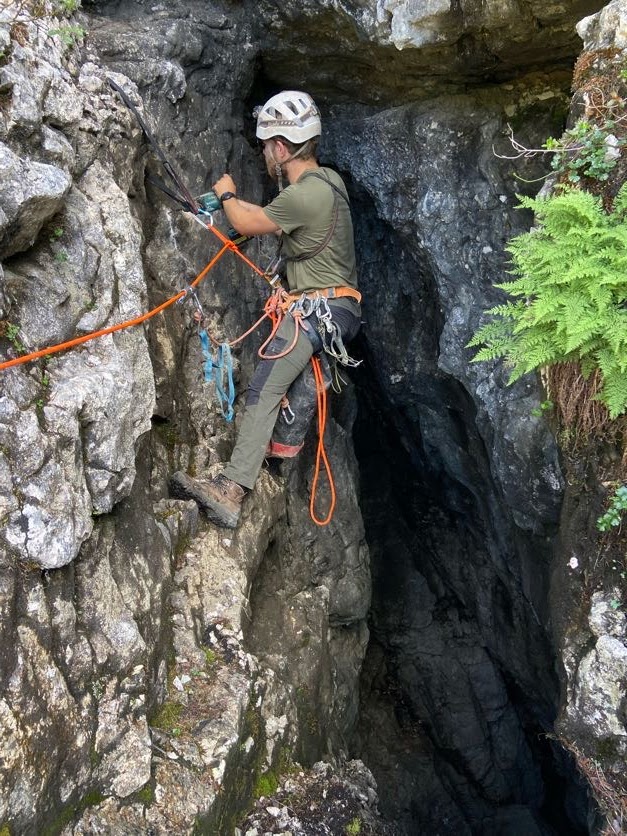
Joel on the Tempest entrance pitch.
The entrance is a short but steep pitch
down to a snow bank which you follow down to a constriction. This then
drops onto another slope which you follow down to another small pitch.
This leads into Narnia Chamber where I met the other three and joined
them in a very, very, cosy bothy bag while we waited for Ash (we were
waiting for him to drop in so we didn’t have rock fall on our heads when
he did). Once Ash arrived we set to work. I have a very vivid image of
Tom in a green poncho collecting a crowbar to pass to Joel to begin the
gardening work.
Ash and I set off in the opposite direction where we surveyed ~100
metres of horizontal passage before it terminated at a rubble choke.
However, the draft continued into the choke suggesting the air was
leaving the cave through a blocked entrance. We then surveyed a couple
of oxbows on the way back.
We found the others had not even begun to bolt their next pitch. Instead
they’d found a nice path down to it through some wonderful ice
formations. Joel was perturbed that Ash had once again killed a very
good lead. Merryn arrived at this point so we reconvened and established
a new plan. Ash, Merryn, and I would go back up to the base of the
first pitch to explore a lead there while the others continued with
their belated pitch rigging.
I ascended all the way to the surface to warm up a bit, where I found
Eli happily reading his book in the rain. I then re-descended once the
other two had reached the point we were to survey. It was just a small
icy vertical oxbow formed of two chambers, one above the other, and
separated by a very tight squeeze. We had it surveyed quick enough and I
decided to leave with Ash and Eli while Merryn returned to help the
others.
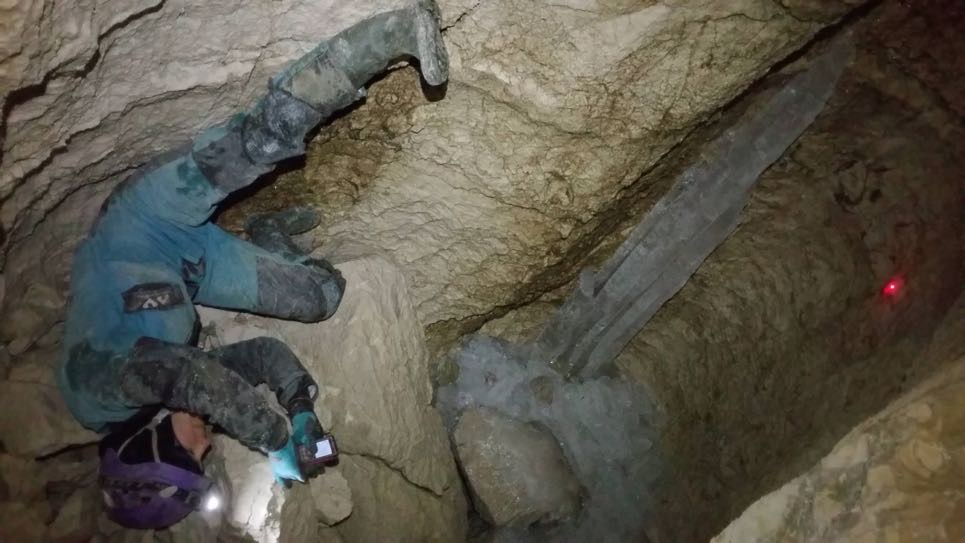
Merryn, surveying in style.
Tempest sadly died the next day when all
leads were exhausted, although not through lack of trying. There was a
large boulder at the top of the final pitch that Joel and Tom worked
tirelessly to move, essentially starting a small dig. But after that the
only going lead died. Merryn and Eli explored a small rift along the
path Ash and I had surveyed but it went nowhere but I’m told was very
Mendipy.
While ultimately a dead-end, exploring Tempest was good experience.
Zac Woodford
|
|
A WET WEEKEND IN IRELAND
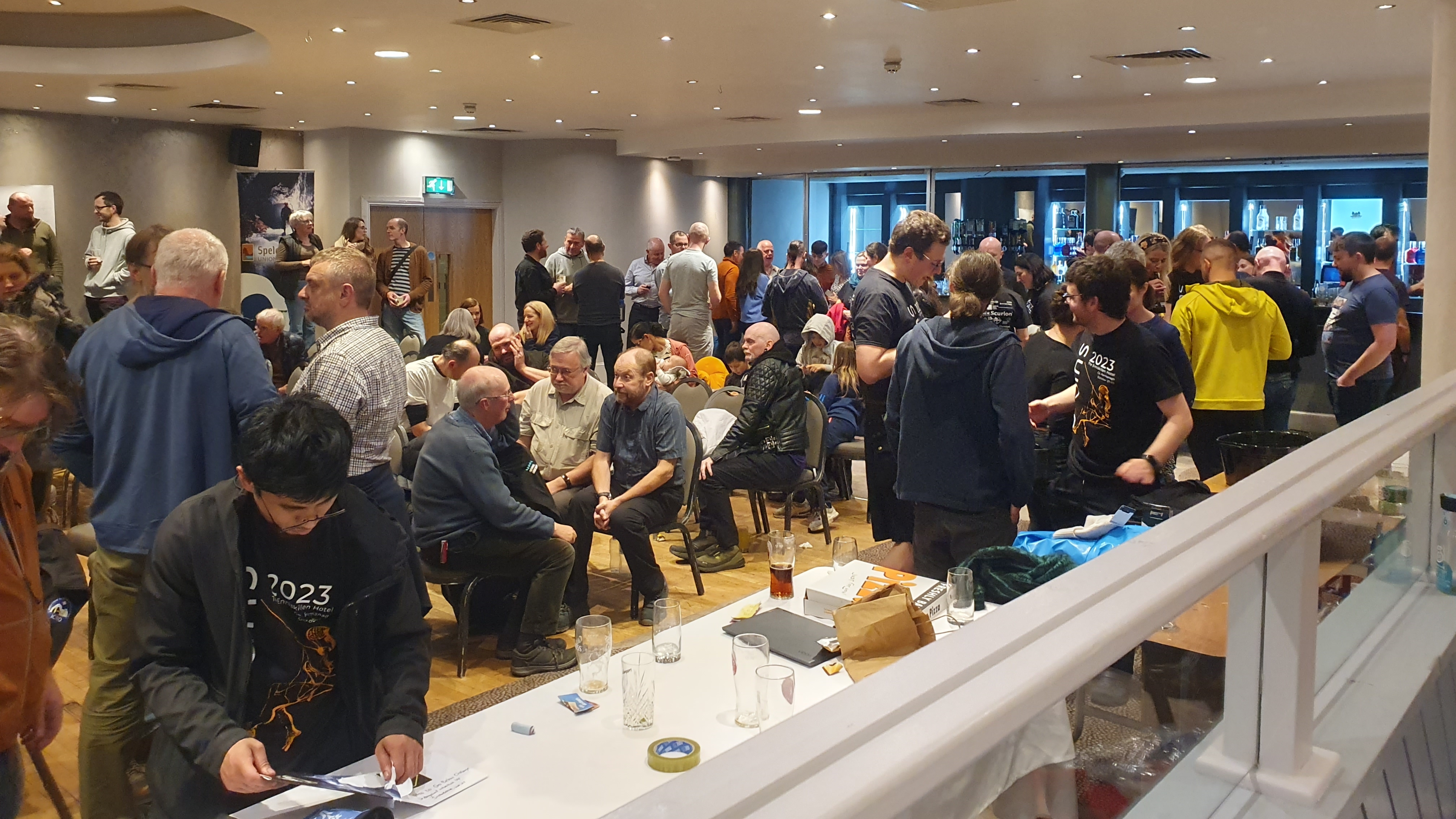
A packed hall in the Enniskillen Hotel.
The last weekend in October
traditiionally sees an unsuspecting hotel somewhere in Ireland playing
host to the annual Speleological Union of Ireland Symposium (SUICRO).
This year it was the turn of the Enniskillen Hotel in, unsurprisingly,
Enniskillen, as Linda Wilson reports.
Graham and I took a scenic tour through Wales, avoiding motorways to
catch the stupid o'clock Stenaline ferry from Holyhead to the Port of
Dublin, arriving at Sparrowfart, to reach Kells for breakfast, and then
on to Enniskillen by mid-afternoon.
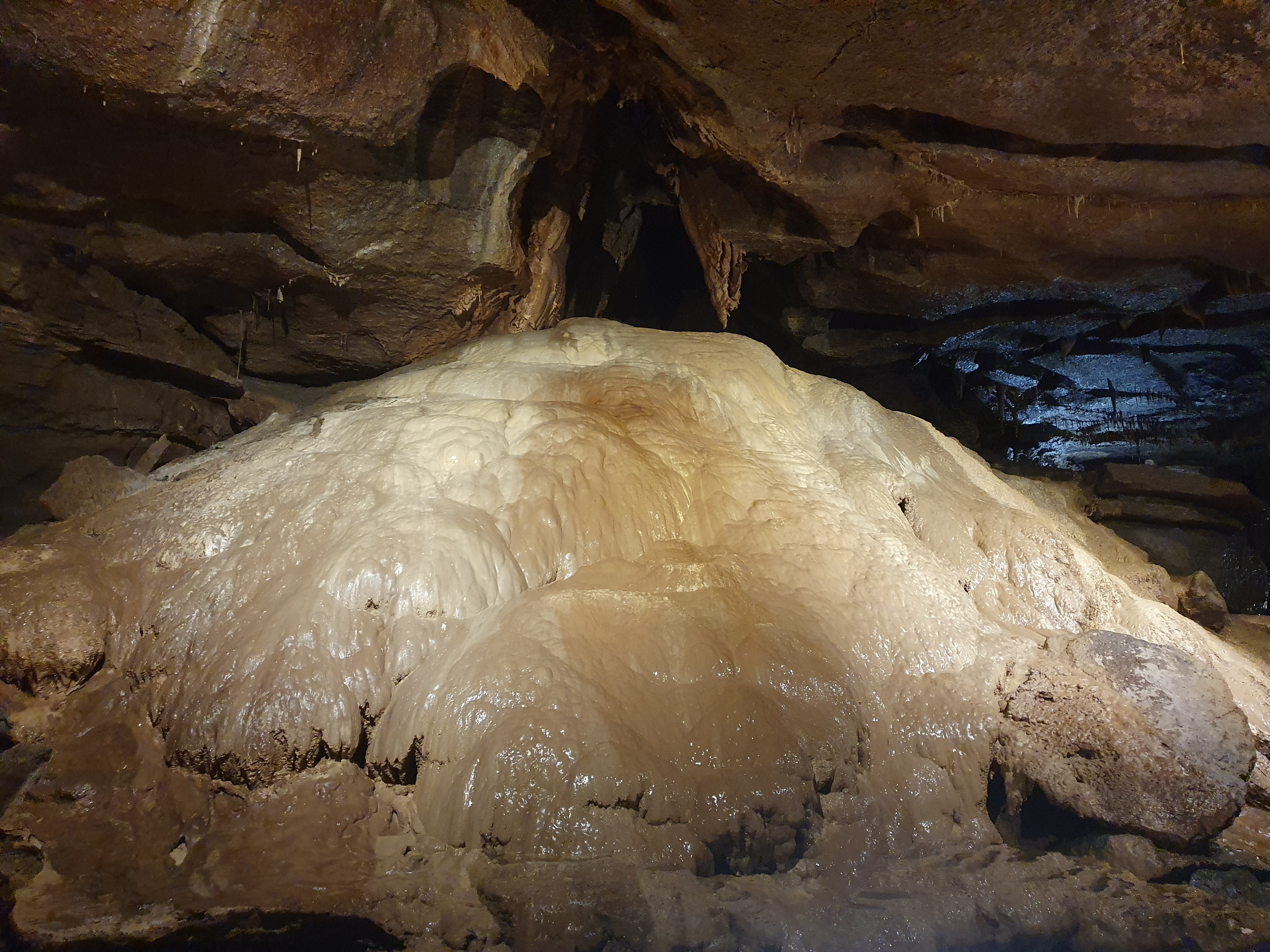
Stalagmite boss, Marble Arch Caves.
The next three nights were spent catching
up with old friends and making new ones. UBSS was represented by Graham
and I, along with Mike Sims, Pete Talling (giving a talk on his exploits
in Peru over the summer, and Chris Howes who wowed the audience with
his stunning photos and made them laugh with the many and varied
exploits of caving model Tom, who once had to attached a large flash gun
to a delicate part of his anatomy with the aid of cable ties in the
name of art. It was just unfortunate that the camera crew didn't have a
knife to hand to spare his blushes when another party stumbled on their
antics.
Chis and Mike went caving on Saturday with a bunch of others to Marble
Arch for a trip to some of the muddier and less pretty parts of the
cave, aptly described by Mike as scrofulous, but he might have been
talking about Duncan Foster's infamous route finding! Chris was
unimpressed by what he considered to be a meagre photographic haul, but
although he definitely suffered for his art, he did get two great photos
of Mike, to follow next month, we hope.
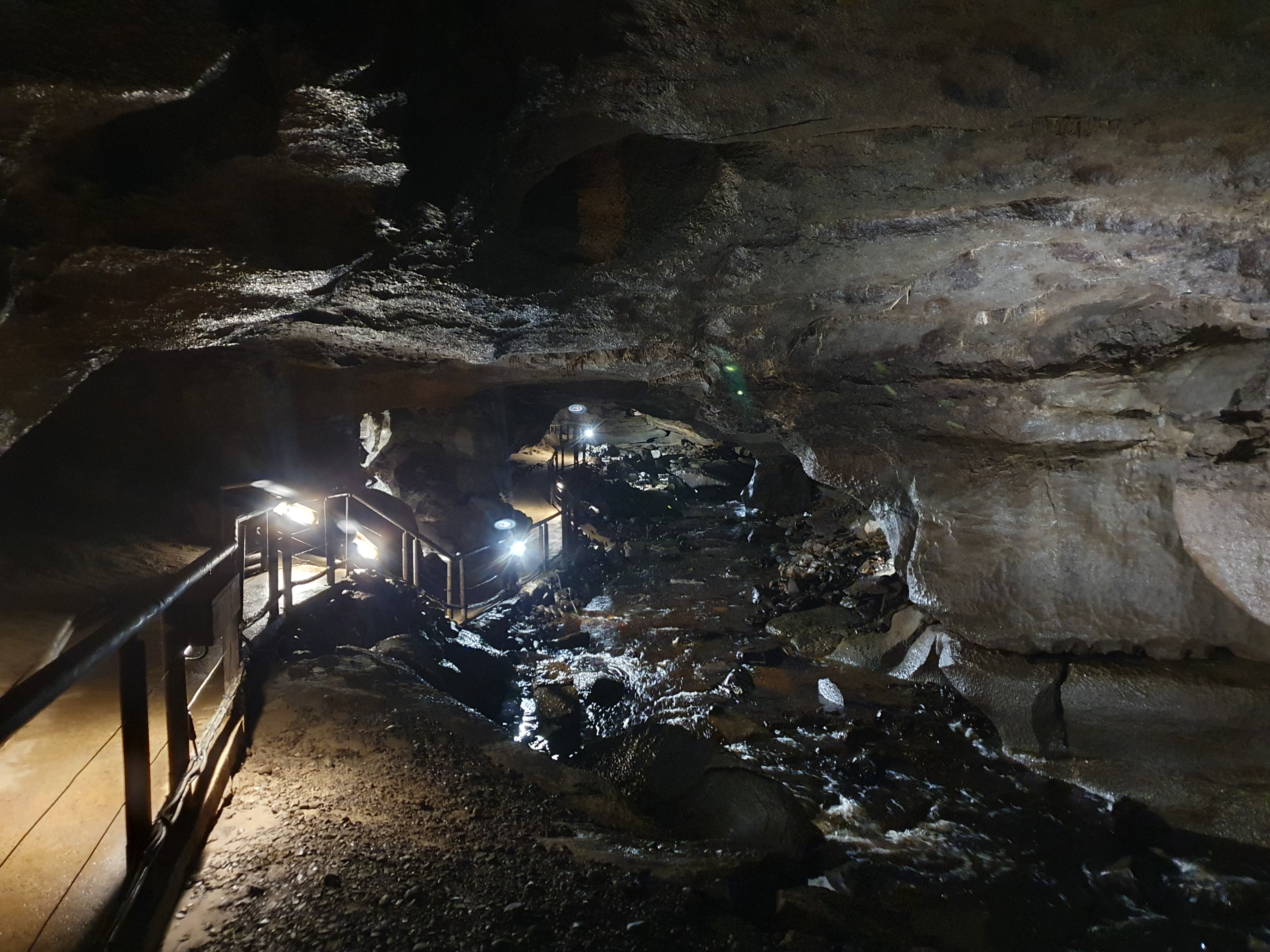
Streamway, Marble Arch showcave.
Graham and I visited the far less
scrofulous parts of the cave by teaming up with a friend we've not seen
for ages and wandering happily through the very pretty showcave,
enjoying the fine mix of passage shapes in the superb streamway.
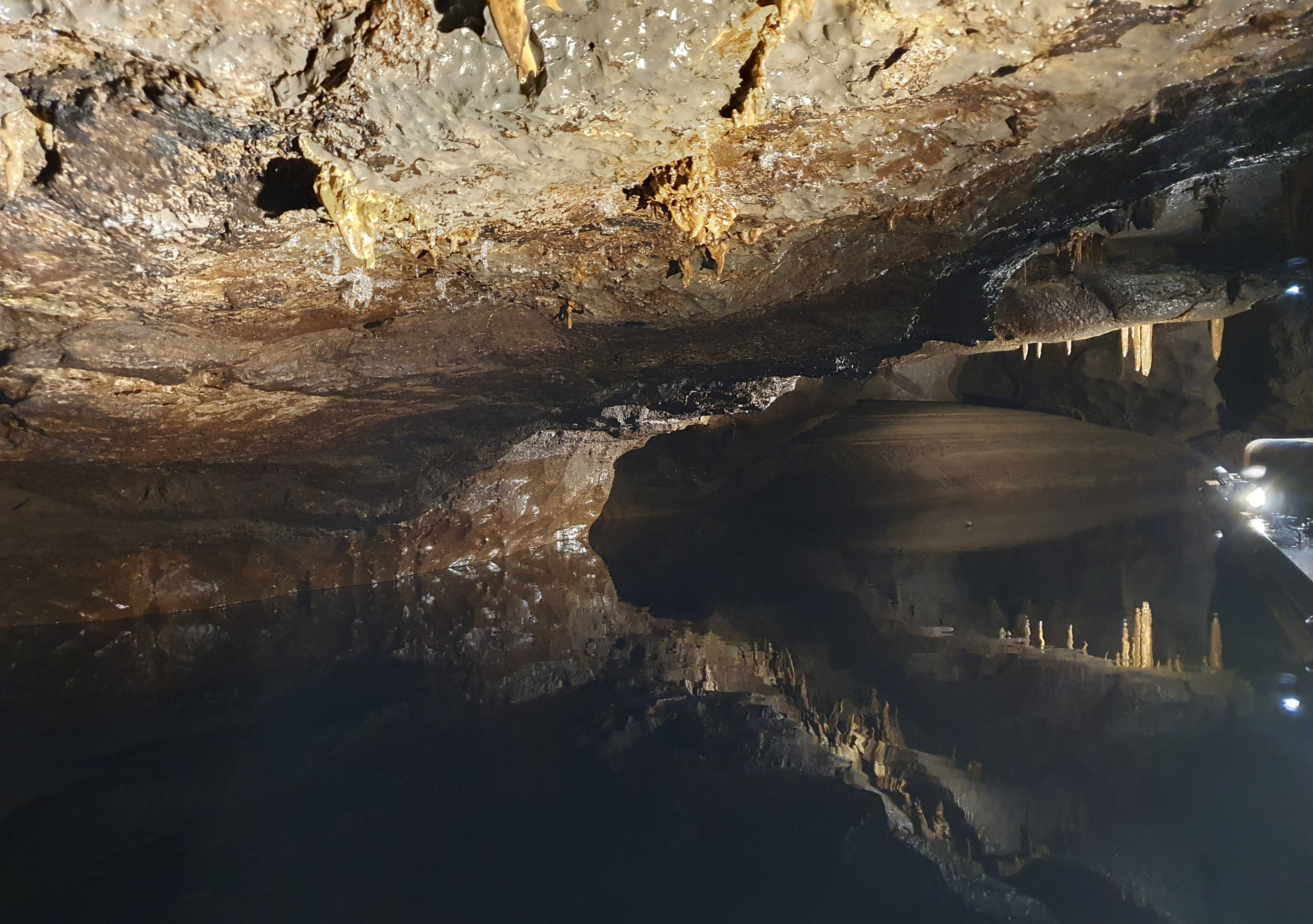
Reflections in a non-scrofulous pool.
On Sunday, we attended the opening of SUI's
new library facility in the Belcoo Community Facility. The library
occupies two rooms, and a large neighbouring room is available to rent
for meetings. The library is dedicated to former librarian Matthew
Parkes who did so much work on it over many years.
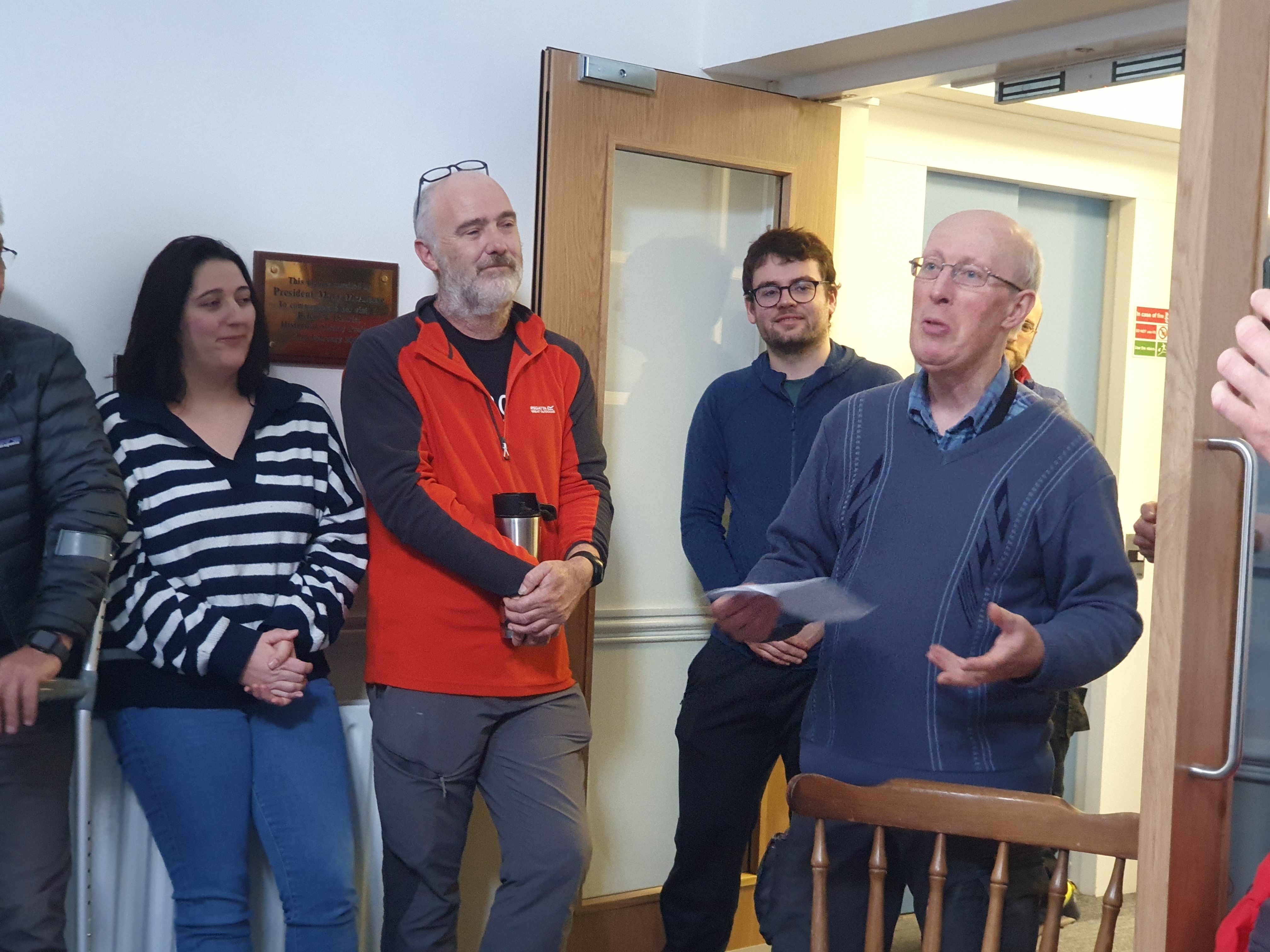
Mike Sims, right, with notes in hand, gives a tribute to Matthew Parkes.
Sunday evening saw the traditional SUI
quiz, with Graham and I forming a team with Mike Sims, Chris Howes and
Judith Calford, together with Irish caver Rob Mulraney. Thanks to Mike's
good memory, we dredged up the name of what might have been our only
winning team, the delightful Person Gives Birth to Ten Pound Trout. The
quiz started with a round on famous generals (the general knowledge
round!) in which we proved to know nothing about US Civil War generals,
but quite a lot about others, earning us an almost clean sweep. Things
went rapidly downhill from there until a round where you had to identify
caves from aerial photos, in which we gained a perfect score. A round
on 'name that knot' saw us puzzling over a short length of rope tied in
various common and uncommon knots. Then there was a round in which you
had to stick your hand in a Halloween goody bag and identify the objects
it contained, by touch alone. We did pretty well there, but sadly
didn't win. Oh well, there's always next year!
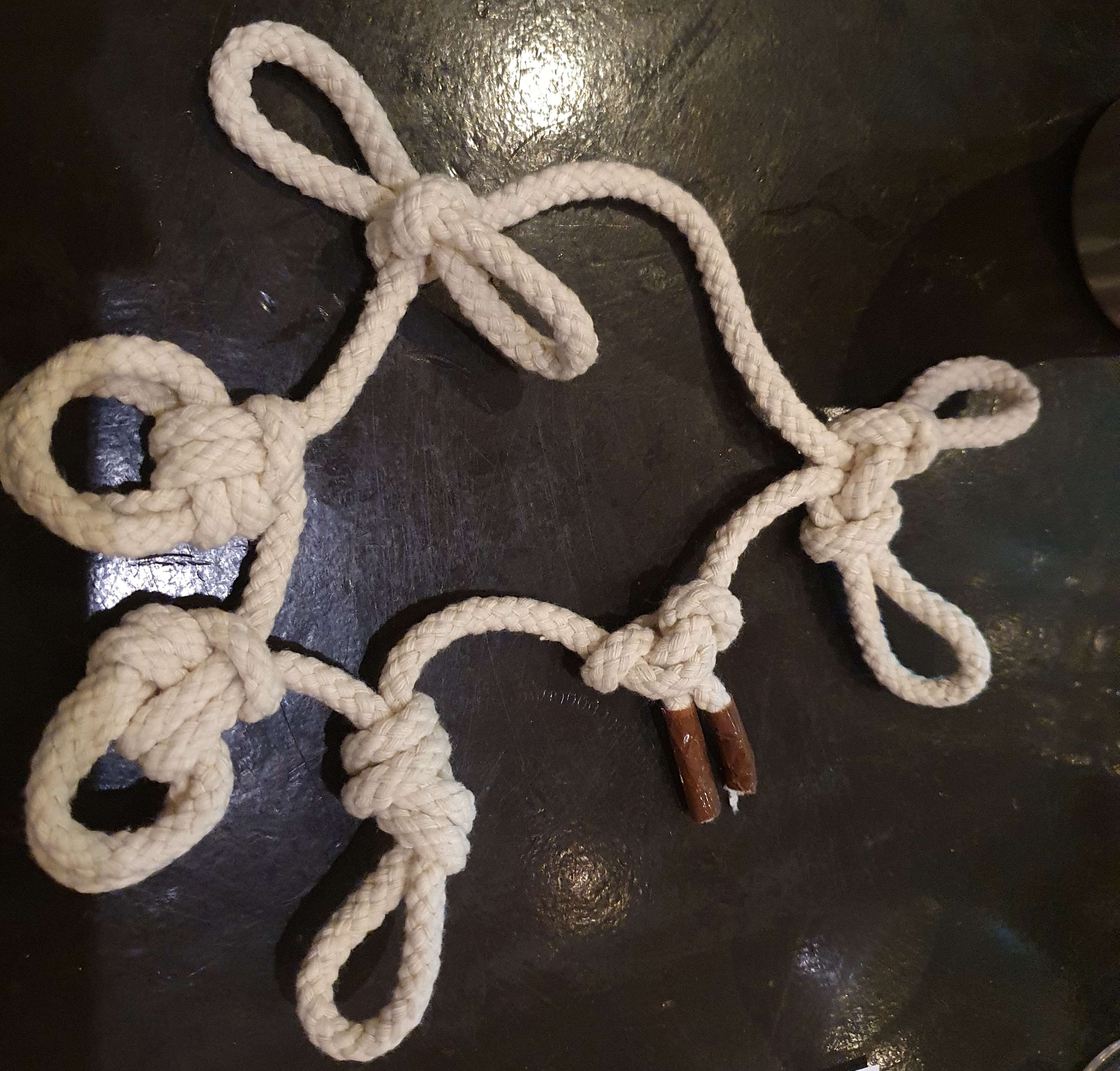
Get knotted! How many of these can you identify?
Unusually, I'd taken my caving gear this
year as I wanted to try out my new Rude Norah light, but as the weekend
was too wet for many caves in the area, I nearly didn't go underground,
until an opportunity presented itself for me to pay a Samhain visit to
the Irish Otherworld, of which more in the next issue.
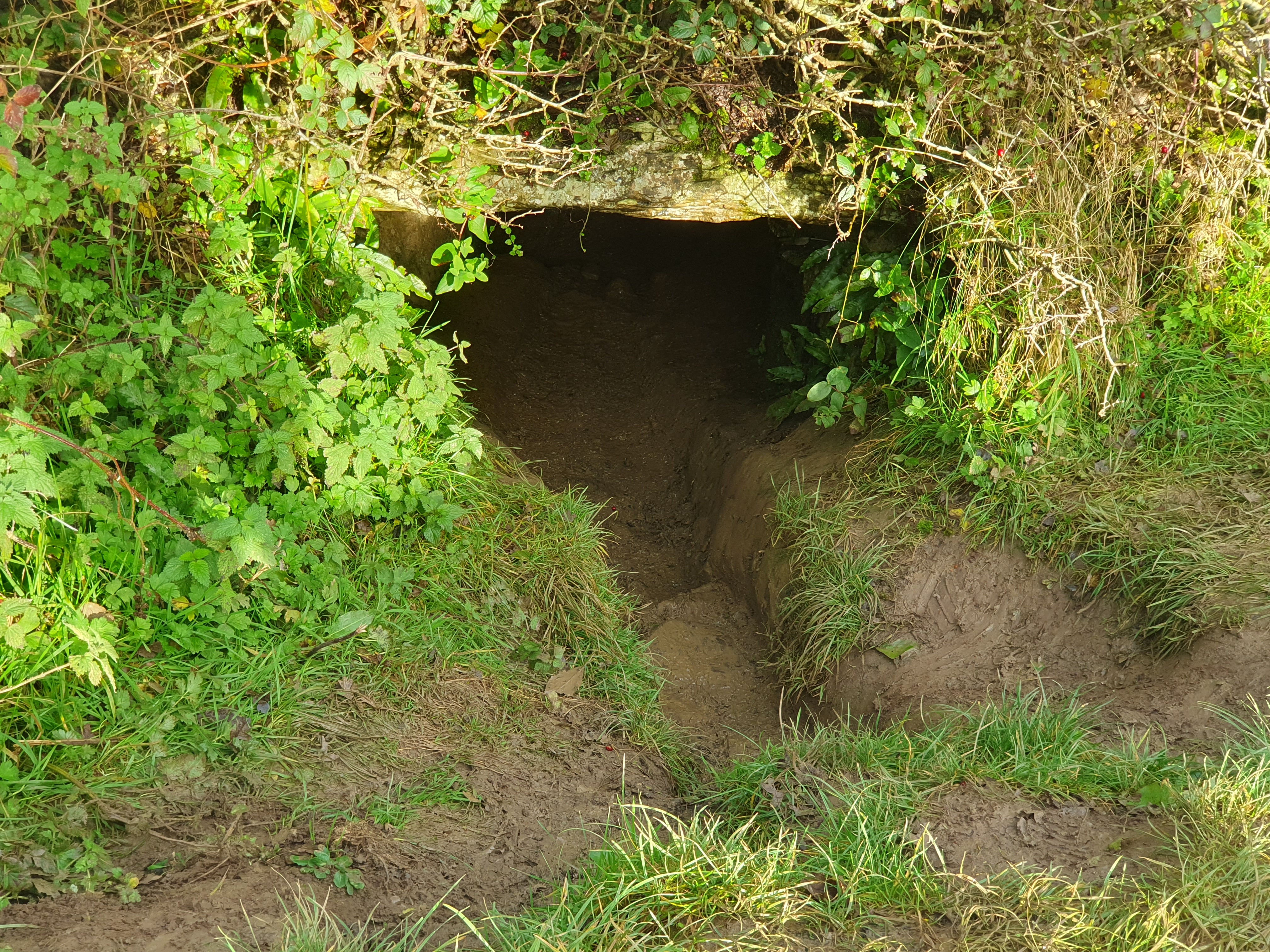 Where were we? Does anyone know? Where were we? Does anyone know?
For anyone who hasn't been to an SUI
Symposium, I heartily recommend it, despite the usual damp October
weather and the shit o'clock ferry crossings.
Many thanks to all the hard-working organisers . It was all a huge amount of fun.
Linda Wilson.
|
|
PERIPATETIC PEREGRINATIONS IN PEN PARK HOLE
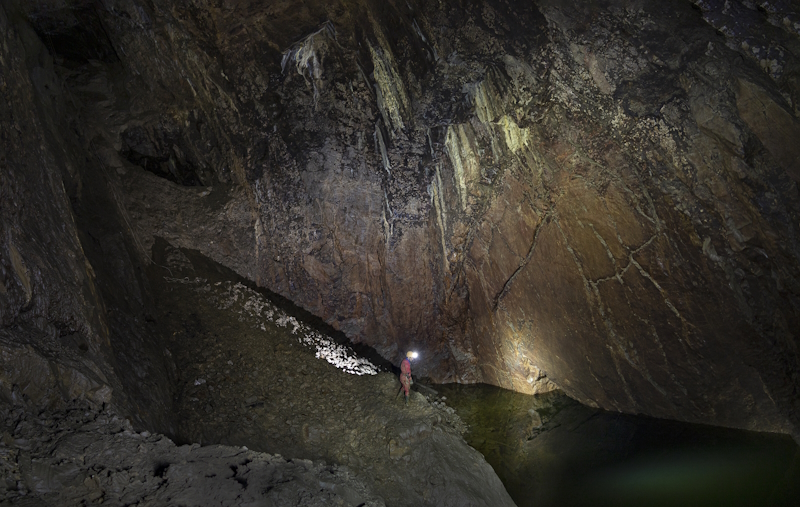
Looking at the lake at the bottom of the main chamber, . Photo copyright Steve Sharp and used with his kind permission.
Although the nights have now drawn
in, Fiona Whitaker has sent in a report of a summer trip in bright
sunshine, proving that you don't even need to leave the City of Bristol
to visit one of the most spectacular caves in the country. With additional photos courtesy of Steve Sharp and used with his kind permission.
The summer solstice is said by some to celebrate the triumph of
enlightenment over negativity and ignorance. In this spirit, and after a
long day of technical presentations and discussion, we left behind the
delights of the dark arts of geochemistry and numerical modelling for
some underground enlightenment. The ‘we’ in question here is a group of
earth scientists from the Universities of Bristol and Manchester and the
British Geological Society, plus members of our Oh-So-Wise project
steering committee. Collectively, we are working to better understand
the source and chemistry of fluids responsible for hypogene cave
development.
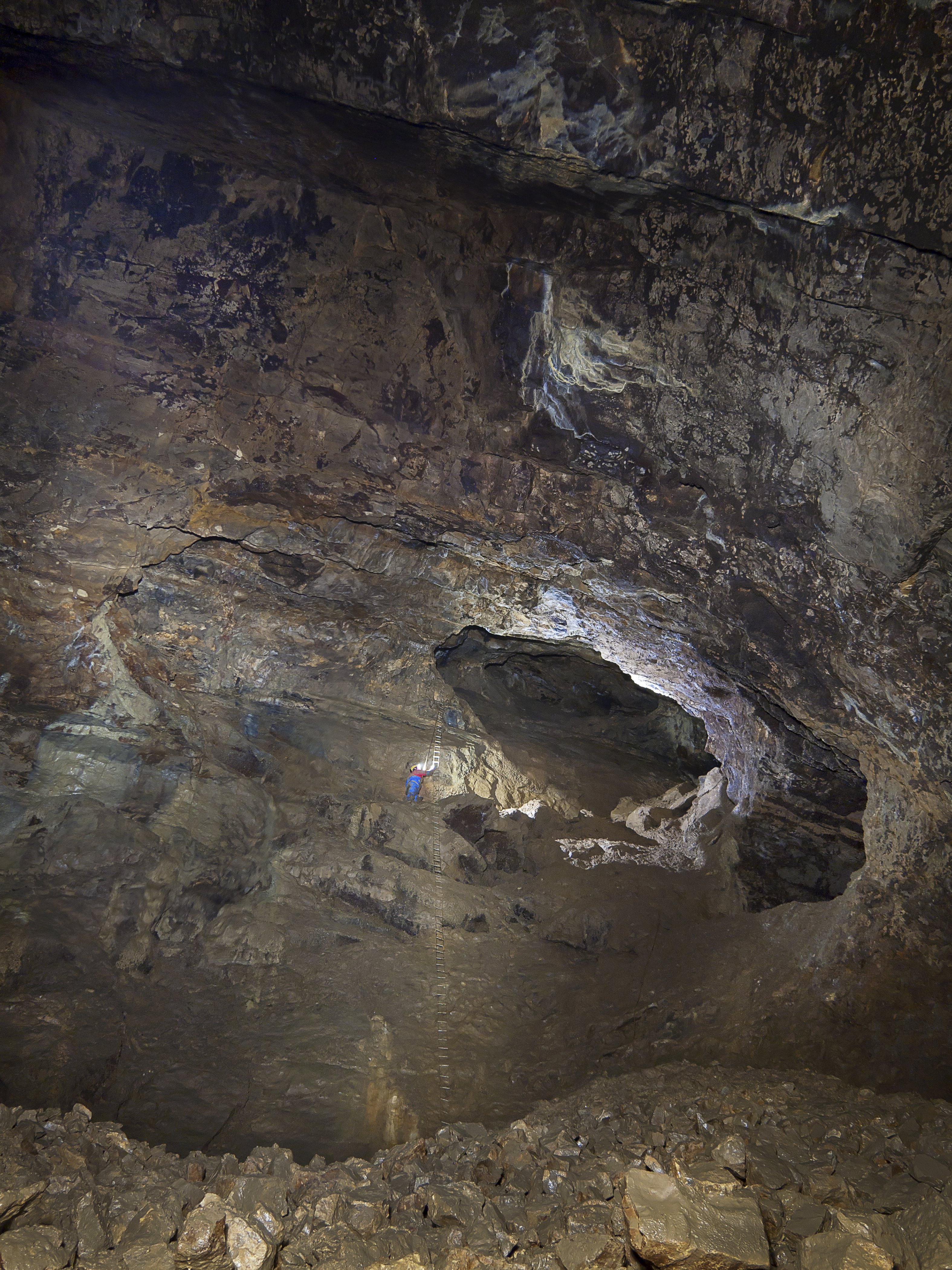
Looking across the main chamber at the
ladder pitch. Yes, it really is that big! Photo copyright Steve Sharp
and used with his kind permission.
In contrast with the more familiar
epigenetic caves formed by shallow circulation of meteoric water sourced
from rainfall, hypogene voids form from the upward flow of aggressive
fluid. This results in a distinct suite of passage morphologies and cave
networks, including vertical pipes as well as more maze-type systems.
The processes driving hypogene dissolution are also distinct, but we
don’t yet have a clear idea about the relative importance of changes in
pressure and temperature as waters rise, the mixing of fluids of
different chemistries, and changes in redox and/or pH due to injection
of CO2 or H2S-rich waters.
Understanding hypogene dissolution isn’t just a matter of speleological
curiosity; these questions are central to predicting the nature and
distribution of hypogene caves and their impact on subsurface fluid
flow. Why do we care where the caves might be at depth? Are caves not
just where you find them? At the risk of getting my metaphors in a
twist, those hypogene passages that extend to the land surface and/or
are intersected by epigenetic passages may be the tip of the
dissolutional iceberg. And such deep networks of caves may have
significance to the energy transition because of their impact on fluid
flow during the production of thermal water.
Although the primary focus of our project is on hypogene caves in
Derbyshire, for this second project brainstorming session we were
meeting in Bristol. We had long discussions about the spectacular coarse
calcite crystals/cements that occur in many of our hypogene caves in
Derbyshire, and that we hope may offer clues to the nature of fluids
circulating at depth. We explored the physical and chemical fundamentals
of the systems that might drive dissolution, and how we might best
(there is no option for most-easily!) represent these in numerical
models. Sustained by the best coffee Bristol could provide, by
mid-afternoon our collective head scratching had yielded the requisite
minimum number of splinters to justify a field visit.
Shunning the obvious temptations of the hot springs at Bath, and the
even more attractive prospect of wallowing in the mud of the tidal Avon
in search of local thermal delights, we settled on visiting the most
spectacular example of a relict hypogene cave within range of the Wills
Building. In fact, one of most spectacular and curious caves in the UK
lies on our very doorstep. Pen Park Hole had long been on my list of
caves to visit (filed under ‘local & weird - cave’ the additional
qualifier to distinguish it from any UBSS members who might fit that
description).
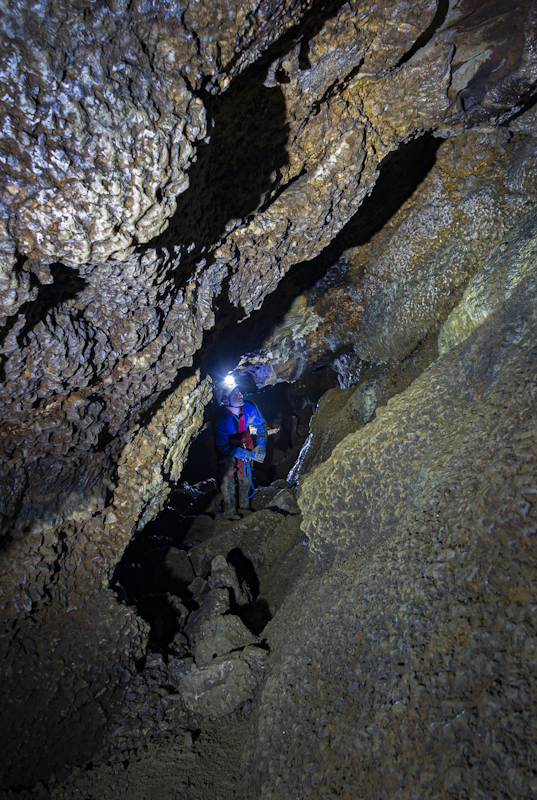
Approach to the ladder pitch. Photo copyright Steve Sharp and used with his kind permission.
Pen Park Hole lies beneath a suburban park
and between housing estates in Southmead (NGR ST 5852 792), on the edge
of the Filton Golf Course. The first record of the cave dates from the
seventeenth century when its discovery was reported during stone
quarrying. The cave is a designated SSSI and CO2 levels in
parts of the system can be high. The current entrance is gated, and
access is managed through a leader system as part of an access agreement
between local caving clubs and Bristol City Council (the access
Secretary is our very own Graham Mullan). The website is
so detailed you can almost convince yourself that you might be better
sitting on the surface enjoying the birdsong and company of the hairy
hounds (and Graham). This would be to miss out on quite a treat – and
Linda’s tales of toppling reverends are much more fun underground! The
history of the cave is illuminated on the website, complete with strange
poetry, so here I will restrict myself to things more hydrogeological -
but possibly no less strange.
From the entrance we descended through a series of small chambers linked
by short climbs, with a series of blind or narrowing to
<Whitaker-sized side passages, all developed along the plane of a
steeply dipping (c.50o) fault. This is apparently a reverse
fault, following the bedding of a narrow (c. 20 m thick) zone of Lower
Carboniferous Limestone. Heading south-west along the fault plane
brought us, after an elegant (or not-so-elegant) straddle manoeuvre, to
an impressive main chamber. With a Farrant anchor, we roped up and took
it in turns to peer over the top of the pitch, our lights showing a
tempting (to some) lake some 25 m below. The water level varies from
just over 50 m to as little as 24 m AOD, hinting at connections to
passages that remain inaccessible to divers due to collapse within Pen
Park Hole.
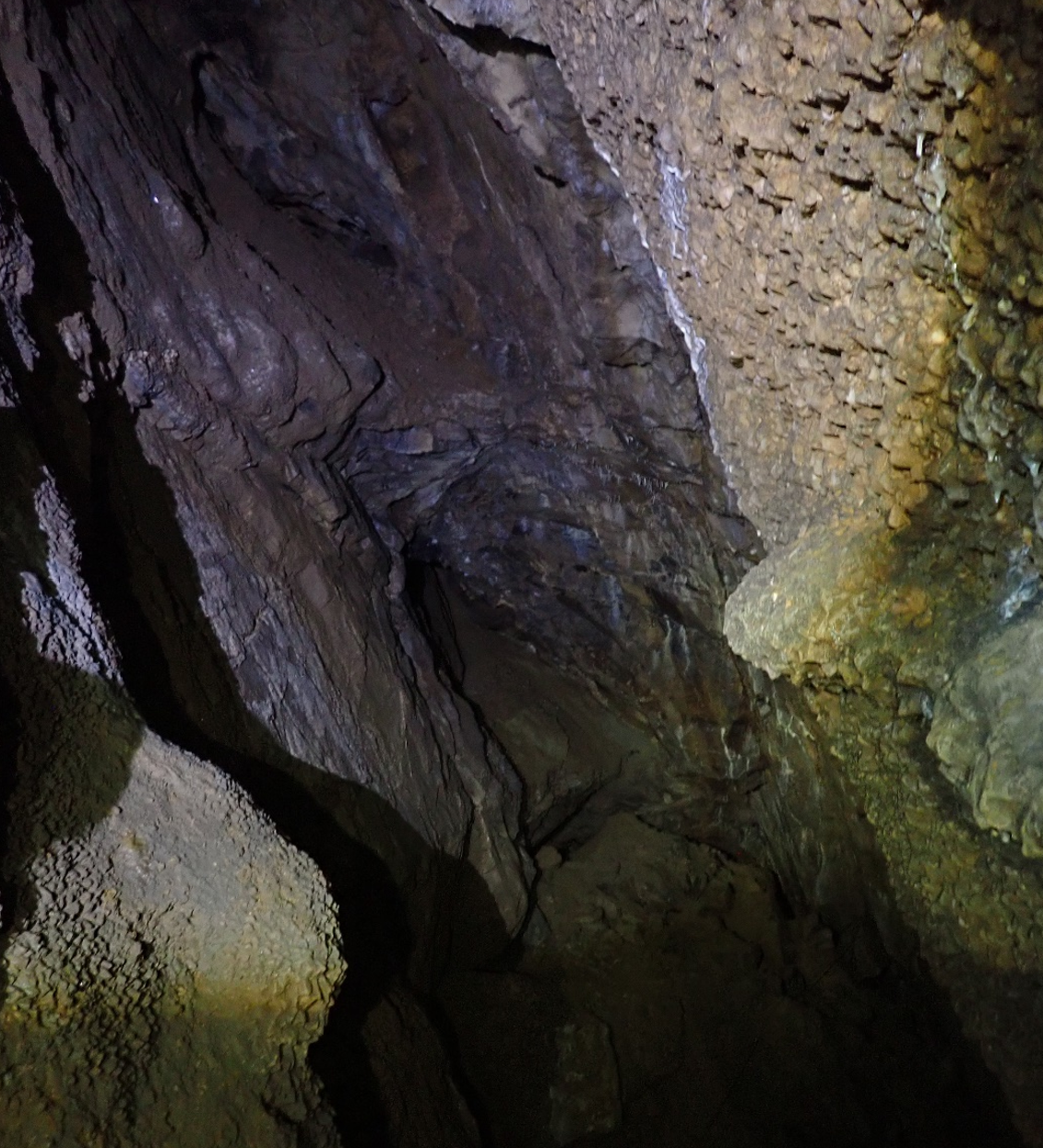
Looking across the top of the main chamber
from the east to the west passage showing strong fault control (Photo:
Fiona Whitaker).
As impressive as the cave morphology is,
what really takes your breath away is that throughout the entire cave
(surveyed length of 112 m), the walls are lined with a spectacular crust
of coarse calcite crystals several cm thick. In places these crystals
have spalled away from the wall and litter the floor. Beneath this crust
we were intrigued by sandy patches of ?dolomite (what self-respecting
Geologist would go underground without a bottle of acid!), reddish
?haematite and even perhaps some limonite. It was not clear to us
whether these formed before the crystal rind or were associated with a
later phase of fluid flow, possibly one that had etched the calcite
crystals throughout the cave. Like most cave science trips, our visit
proved to us that it is not possible to go too slowly through the cave,
and that there is never enough time underground.
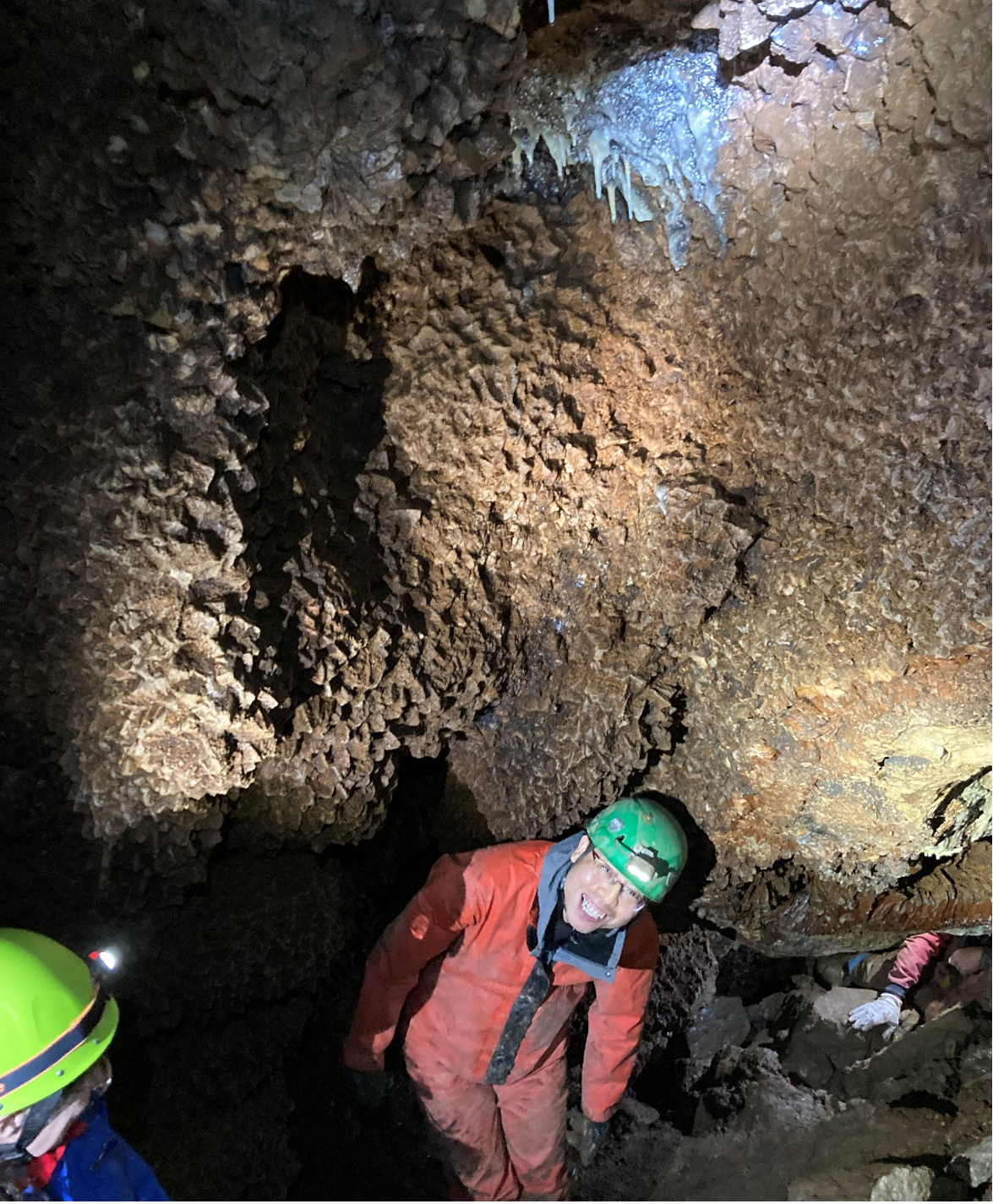
Bristol postdoc Wenwen Wei, overwhelmed by
enthusiasm for coarsely crystalline calcite - or is it just that he had
to squeeze into my oversuit? Photo courtesy of Andy Farrant.
In a way only geologists can, we had fun
speculating about possible mechanisms by which fluids rising through a
bed of limestone could flip-flop from at one time dissolving the
sizeable original cave void, to then being so calcite supersaturated to
form the thick rind of crystals, and then again to undersaturation, as
evidenced by the etched crystals and rounded crystal terminations. What
is clear is that rising thermal waters rising through the Carboniferous
Limestone must have focussed to discharge at a low point in the
overlying topography.
Once again, we rued the loss of our friend and colleague Alexander
Klimchouk, who previously suggested this may have occurred during the
early Pleistocene (as Andy has long suspected), but that a Jurassic age
cannot be ruled out (Klimchouk et al. 2017, DOI 10.1007/978-3-319-53348-3_2).
This is significantly younger than the Permo-Triassic age originally
proposed by Bristow in 1963 (for this reference and a lot more detail
see the 1993 paper by Graham
in the UBSS Proceedings). Simplifying the evolution to three phases
also begs the question of how much time separates each period of fluid
flow. Frustratingly the abundance of galena precludes the use of
uranium-lead to date formation of the crystals.
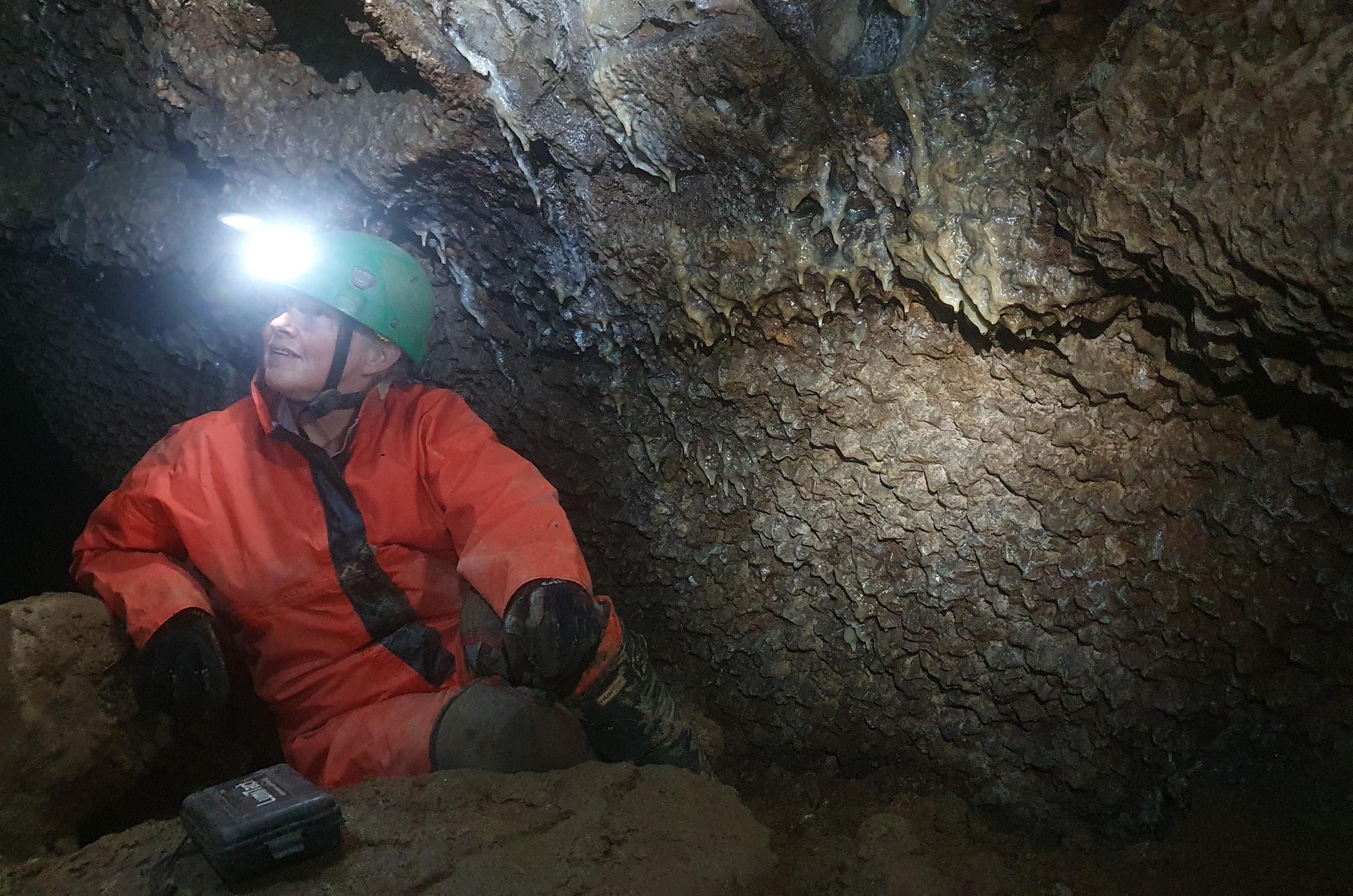
Professor Fiona Whitaker in Pen Park Hole. Photo by Linda Wilson.
We hope however, that the crystals may
provide a record of fluid composition and - funded by a small grant from
the International Association of Sedimentologists - we will compare
samples from Pen Park Hole with others from the vein fill in Sandford
Quarry. Thin (very, very thin – just 40 mm – that’s 0.04 mm or about
half the width of a human hair) polished sections will be prepared and
analysed under optical transmitted light, cathodoluminescence (CL), and
scanning electron (SEM) microscope to see if the crystals are zoned –
suggesting changes in source fluid during their formation. From each
zone, we will collect powders to carry out analysis of major and minor
elements composition and stable isotopes, as has also been undertaken in
Derbyshire as part of our main project. In this way, we hope to be able
to estimate the origin of the fluids from which these calcite crystals
have precipitated.
Thanks to Linda and Graham for facilitating the visit, and to Andy
Farrant and the rest of the team for fun discussions. Whilst not all of
you reading this will share the excitement of the project team about the
results of our analyses of the coarse calcite crystals, there is no
doubt that anyone with even a passing a curiosity about hypogene fluids
and the caves they form would enjoy a chance to explore Pen Park Hole.
Apologies Graham if this precipitates a flood of requests!
Fiona Whitaker (University of Bristol)
Alessandro Mangione (University of Manchester)
|
|
PUBLIC SERVICE ANNOUNCEMENTS
CALL FOR HARNESS REINSPECTION
If you have a Petrzel Astro or Canyon Guide Harness, please note there's been a call for reinspection. Further details can be found on the BCA website. If you have one of these, please inspect, following the guide given by the manufacturers.
SUSPENSION TRAUMA
The British Caving Association has issued some guidance about how to minimise the risk of suspension trauma when undertaking SRT. This is a worthwhile read for anyone going on SRT trips.
LIGHTS
Following a discssion on WhatsApp about
lights, thanks to Sara for reposting some useful advice from UBSS member
Henry Morgan on the subject of back-up lights, that deserves to be more
widely seen
"A note on primary and back up lights: You want your secondary to be as
reliable (if not as 'good') as your primary, and if this is something
you are thinking you might buy in the future it is worth thinking about
cross compatibility of batteries (so you don't have to take two types
into a cave). Some people will have a helmet mounted as a primary and
then a single cell 18650 Li-ion light as a back up. I personally have
two single cell Li-ion cell lights and use them interchangeably (HM61r
and HL65r) which means I know they are always charged when I go into the
cave as my backup gets used frequently. I see nothing that I am missing
with my current set up as one of them is floodier and one is spottier
but I can cave well on both with fantastic battery life. (Berger on just
two cells)."
For anyone interested in purchasing their own lights. please do chat to
other cavers about their preferences and recommendations. And Tony
Seddon of Starless River
also gives great and very impartial advice and is a great source of
gear. He frequently visits Mendip where you can buy from him in person
as well as online.
SWILDON'S CHANGING BARN
Repair work is shortly to be carried out to
the Swildon's Changing Barn on Priddy Green so the barn will be
unavailable for use from 10th to 20th November 2023, so during that
period cavers should arrange to change elsewhere or arrive in their
caving gear and leave the same way, to avoid offending local residents.
Please note that the barn is made available to cavers by Robin Maine,
who owns the cave, so please always remember to pay your goodwill fee
when visiting the cave, as good landowner relations are priceless. The
work is being carried out by the Council of Southern Caving Clubs. If
you are able to help on those weekends, please contact the CSCC Conservation and Access Officer Wayne Starsmore, who is keen for some additional workers.
COMPTON MARTIN OCHRE MINE
The land around the mine has recently
changed hands. CSCC are endeavouring to contact the new owner to see if
they are willing to continue with the previous access arrangements via
CSCC. In the meantime, please don't visit until CSCC is able to confirm
that the new landowner is happy with trips taking place.
SINGING RIVER MINE
Access has recently been restored to
Singing River Mine in Shipham and a new gate has been installed by CSCC
at the landowners request. For details on the latest access arrangements, please visit the CSCC website.
CSCC GENERAL MEETING
As you'll see from the above, our local
region council, the Council of Southern Caving Clubs, carries out a lot
of work on behalf of cavers. UBSS is a member of CSCC. The next general
meeting is at 7pm on 13th November on Zoom. Meetings usually take no
more than two hours and anyone can attend, but only club reps can vote.
Please do come along if you would like to know more about what goes on
in our area. If you're interested, contact Linda Wilson for the joining link.
We're also very grateful to CSCC's Training
Officer, Dave Keegan, who spent the Saturday of the Freshers' Weekend
at the Hut teaching people how to tie knots. This provided a fun and
useful way for people to pass the time when they weren't caving or
collecting wood. Dave will also be arranging some SRT training for
members at some point, in addition to our own training in the Richmond
Building.
ACCESS TO LONGWOOD VALLEY - WEATHER WARNING
With the number of storms lashing the area,
if you're planning a trip to Longwood or Rhino Rift, it's worth taking a
moment to familiarise yourself with the access condition for Longwood
Valley, as high winds greatly increase the risk posed by ash die-back in
the woods. You can find all the details on the CCC Ltd website. And at the same time, you can get your permit at the CCC Ltd online portal..
This permit will remain valid until the end of the year. You need this
before visiting any of the CCC Ltd caves, including GB Cavern and
Charterhouse Cave.
|
|
SHAFTED!
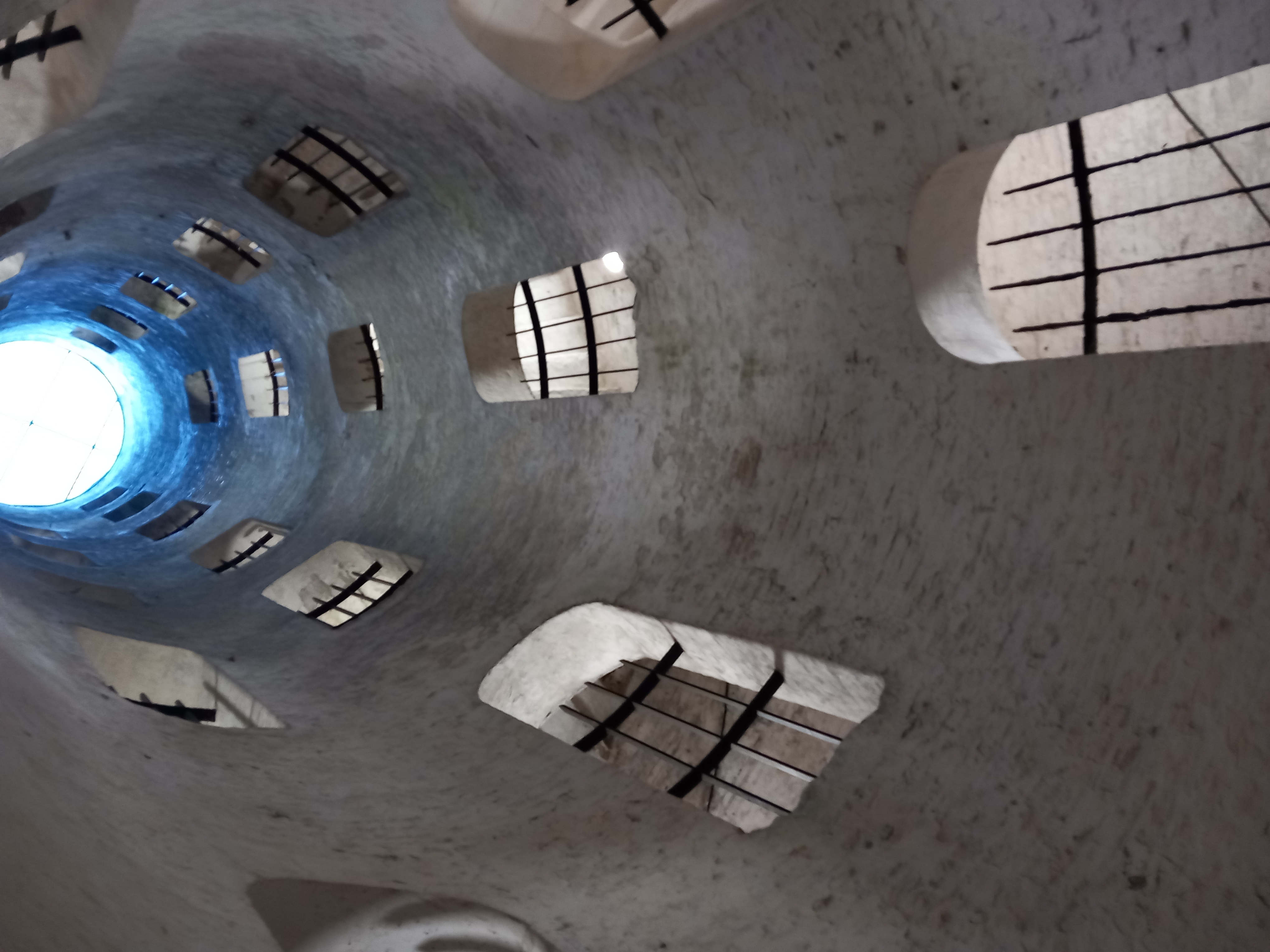
We're always open to unusual
photos, and this month's comes courtesy of Barbara Sim. Any resemblance
to the stairwell in the Richmond Building is wholly coincidental.
No, it's not Gaping Ghyll, nor even
Gormenghast Castle! This is the Dover Western Heights Grand Shaft -
three parallel helical stairways linking the Western Heights Barracks to
the bars and brothels of old Dover. And to get the troops down to the
beach quickly to repel any invaders, whether Napoleon, Kaiser Bill or
Hitler.
Barbara Sim
|
|
SAY HELLO TO THE BAT

Batti comes to you courtesy of Bing AI.
Thanks to everyone for the
responses to the newsletter last month! Our second prize winner of
the year in the Read to the End Stakes is Joseph McElvoy who joins
Daniel Rose on the 2023/4 leader board. I haven't forgotten your prizes,
so let me know if you'll be at Bonfire Weekend and I hope I'll see you
there! And if anyone would like to acknowledge ploughing through our
deathless prose but can't think of anything to say emojis, clip art or
anything you'd like to throw our way (except mud and cowshite) is always
welcome, as is fawning praise such as 'you are all awesome' and 'we've
nominated you for the Booker Prize' is equally fine! So use the link at
the end of this dection and let's get those emojis flooding in! Raccoons
are particularly welcomed!
- Me me Me!!! [Graham Mullan}
[Editors' note: disqualified as usual as he presses the button to send
this out, but we appreciate the sentiment and the help!]
- Wheee [Joseph McElroy]
- “You can never ruin a trip, after all, if you don’t bottom the cave, it’s not going anywhere,
you can always come back another time.” A serious comment for a
change. Zac has such good advice. I take photos and in all my years
underground, I’ve not been to the end of an awful lot of (even commonly
visited) caves. Just enjoy the experience; there’s no need to treat
caves as an Everest to be conquered.
‘And I must go down to the sea again ...’ No, wrong. ‘And I must go down to the museum sometime ...’ [Chris Howes]
- good for me good for you good for everyone :) [Daniel Rose]
- Thanks for another 30 minutes of entertainment. Very interesting
discussion about on-line proceedings versus printed copies. I had
to dispose of my printed proceedings, as my shelves were full.
But, my hard-disk can deal with digital newsletters, and I can always
check out earlier news on-line. Good on UBSS to be ahead of the
curve - and lower costs as well! I had memories of Manor Farm Swallet
when reading the report by Dan. Mud is not always mud 😷. [Hans
Friederich]
- A good read! Especially on the UBSS standpoint of the newsletter and how easy it can be. [Jess Brock]
- Has just gone 4 pm here - so I'm probably not the first. [Stu Walker]
- I read to the end digitally and am delighted that it
hasn’t meant more physical clutter for my rather aged home library!...
from someone who was UBSS librarian in the 1960s! [Eve Gilmore]
- Welcome to the new members! Lovely newsletter, as always, great pictures and informative articles. *meep*
for the “Cow mud”. I’m in full agreement with those who prefer the
digital output – after a while, one runs out of space for physical
newsletters. [Jan Walker]
- Another excellent newsletter, thank you. I know I’m a day late
replying (and already the proud owner of an UBSS mini torch), but it’s
well worth saying that I read to the end every month, I LOVE
receiving the newsletter, especially now that I rank amongst the
far flung alumni. It’s so nice to hear the caving stories and updates on
what the students are up to, and I always really enjoy the editorial
tone. Also congratulations on the museum, was genuinely gutted when the
call went out the other Saturday that I couldn’t pop down to help, can’t
wait to visit (perhaps when you come down to graduate in February?).
Much love to the wonderful editors (I’m looking at you Linda) Xx
[Kat Osei-Mensah]
Say hello to the Bat!
THE END
|
|
|
|